Text
Final - Watchmen

Introduction:
Fanon in “The Negro and Psychopathology” delves into the psychological repercussions of racism and colonialism on Black individuals, highlighting the internalization of negative stereotypes and its manifestation in neurosis. Fanon discusses how cultural indoctrination can lead to alienation and neurotic behaviors, emphasizing the importance for Black individuals to confront and overcome internalized oppression for genuine self-realization.
bell hooks in “Oppositional Gaze: Black Female Spectators” explores the concept of the "oppositional gaze" of black female spectators in relation to mainstream cinema, and discusses how black women have developed critical viewing practices that resist and challenge the racist and sexist representations of black women on screen.
Audre Lorde in “Age, Race, Class, and Sex: Women Redefining Difference” shows the importance of recognizing and embracing differences between women, particularly differences of race, sexuality, class, and age, to build a strong feminist movement. Lorde argues that ignoring these differences and pretending that a homogeneous "sisterhood" exists is a failure to confront the very real oppressions faced by women of color, lesbians, the working class, and the elderly.
Robert Stam and Ella Shohat wrote “Stereotype, Realism, and the Struggle Over Representation'' to analyze representation of ethnic and racial minorities in film, particularly the limitations of a "stereotypes and distortions" approach. It argues for a more nuanced analysis that considers the orchestration of discourses, perspectives, and voices within films rather than just the accuracy of character portrayals.
This paper will analyze how Watchmen explores the identities of its characters, like Angela and Jon Abar, by authentically portraying different aspects of their identity, especially race and gender, employing innovative storytelling techniques to achieve these explorations. By delving into Angela's grandfather’s ancestral memories in black and white and depicting the non-linear events of experiences of Jon and Angela’s journey in episode 8, the show not only embraces their identities but also utilizes these aspects to enrich their character development and deepen our comprehension of their narratives.
The analysis will initially examine the shared themes among Fanon, hooks, Lorde, and Stam and Shohat’s papers, before delving into their divergent perspectives. Through Reeve’s pivotal transformation scene into Hooded Justice and the moment between Angela and Jon, where they decide on Jon's new identity to hide his true form, the paper will explore how the ideas presented in these readings intersect, demonstrating the efficacy of episodes 6 and 8 in exploring and expanding upon the characters' identities.
Section 1:
These readings all investigate the psychological and social repercussions of their respective issues, particularly racism, sexism, and stereotyping on marginalized groups, emphasizing how entrenched cultural narratives perpetuate harmful stereotypes and oppressions, while advocating for the empowerment and redefinition of marginalized identities through resistance, self-representation, and collective action against oppressive systems.
Fanon's reading shows how dominant cultural narratives and representations, such as those found in children's magazines and literature, are perpetuating harmful stereotypes and oppressions against Black people. He argues that these narratives, created by white authors for white children, often depict Black people as evil and savages, which then lead to the internalization of these negative stereotypes by Black children, who also digest these narratives as children. As Fanon states, "In the magazines the Wolf, the Devil, the Evil Spirit, the Bad Man, the Savage are always symbolized by Negroes or Indians; since there is always identification with the victor, the little Negro, quite as easily as the little white boy, becomes an explorer, an adventurer, a missionary 'who faces the danger of being eaten by the wicked Negroes.'" (1) To counter this issue, Fanon advocates for the creation of empowering narratives and representations specifically for Black children through the media they consume, such as magazines, songs, and history texts, to shape their worldview and identity in a positive way that allows them to embrace their race.
hooks similarly examines how dominant cinematic narratives have perpetuated harmful stereotypes of Black women, citing the portrayal of "Sapphire" in Amos 'n' Andy as an example: "was not us. We laughed with the black men, with the white people. We laughed at this black woman who was not us." (2) She underscores how these representations deny the full humanity of Black women, advocating instead for the development of an "oppositional gaze" as a form of resistance. This gaze, she argues, empowers Black women to challenge oppressive narratives and assert their subjectivity and humanity in the face of erasure or degradation. By rejecting the limiting roles assigned to them and reclaiming their agency through critical engagement with media, Black women can assert their voices and reshape dominant narratives to reflect their lived experiences and complexities.
Audre Lorde dives into the ways dominant cultural narratives and representations perpetuate harmful stereotypes and oppressions, arguing that these narratives fail to recognize and address the diverse experiences of marginalized groups, including women of different races, classes, sexualities, and ages. She contends that attempting to use the tools and structures of oppression to dismantle the systems that created them is futile, as evidenced by the maxim, "the master's tools will never dismantle the master's house." (3) She also critiques academic feminism for its neglect of these differences, which leads to a false sense of homogeneity under the banner of sisterhood. Lorde contends that confronting and dismantling distortions such as racism, sexism, ageism, and others is essential for true empowerment and liberation. She advocates for embracing differences as sources of creative potential, enabling marginalized individuals to redefine themselves and construct a future that acknowledges and celebrates their diversity.
Finally, Stam and Shohat concurrently explore how dominant cultural narratives and representations perpetuate harmful stereotypes and oppressive structures, while advocating for empowerment and more nuanced portrayals. They also critique individualistic analyses of stereotypes, advocating for a holistic approach that recognizes their contradictory nature and diverse discourses. They support showing different voices in representations, helping marginalized groups speak up authentically and fighting against discourses that silence them. The authors caution against simplistic analyses and advocate for a discursive approach that considers multiple voices and perspectives within representations, stating, "Less important than a film's 'accuracy' is that it relays the voices and the perspectives - we emphasize the plural - of the community or communities in question." (4)
Section 2:
Despite examining similar issues, the variations among these readings lie in their emphasis on agency and resistance in addressing oppressive systems, ultimately diverging in their approaches to overcoming or confronting harmful stereotypes.
Fanon emphasizes the agency and resistance of the colonized in confronting oppressive systems and harmful stereotypes, and believes in resisting oppressive systems through asserting agency and refusing to internalize harmful ideology. Fanon argues that despite the pressures to assimilate into white society, the young Antillean demonstrates agency by refusing to fully internalize oppressive structures. He describes how the Antillean navigates between familial and societal expectations, ultimately rejecting the notion that Blackness equates to savagery and inferiority. Fanon's assertion that "the Negro recognizes the unreality of many of the beliefs that he has adopted with reference to the subjective attitude of the white man." (5) highlights the colonized individual's capacity to resist and challenge harmful ideologies. This resistance, as depicted by Fanon, is integral to combating and overcoming stereotypes.
hooks emphasizes the agency and resistance of black female spectators in confronting oppressive systems and harmful stereotypes through cinema. She introduces the concept of the "oppositional gaze," developed by black women in response to the lack of positive representation and the perpetuation of degrading stereotypes in mainstream films. According to hooks, this resistance involves actively disrupting dominant structures, as stated: "Even in the worse circumstances of domination, the ability to manipulate one's gaze in the face of structures of domination that would contain it, opens up the possibility of agency." (6) She explains how black female spectators found pleasure in resisting the uncritical consumption of these images, primarily focusing on confronting issues of race and racism through critical examination.
Lorde believes that recognizing and embracing differences are integral components in confronting oppressive systems. Lorde advocates for viewing these differences not as sources of separation and suspicion, but as catalysts for transformative change. Lorde thinks that "difference must be not merely tolerated, but seen as a fund of necessary polarities between which our creativity can spark like a dialectic." (7) Lorde challenges the conventional notion that oppressed groups bear the responsibility of educating their oppressors, denouncing it as a diversion of energies. Instead, she calls for marginalized communities to concentrate their efforts on "redefining ourselves and devising realistic scenarios for altering the present and constructing the future." (8) This approach, according to Lorde, empowers marginalized groups to reclaim agency over their own narratives and resist harmful stereotypes autonomously, rather than relying on the goodwill of their oppressors.
Stam and Shohat argue that "spectators themselves come equipped with a 'sense of the real' rooted in their own experience, on the basis of which they can accept, question, or even subvert a film's representations." (9) They show how marginalized groups have actively protested and challenged stereotypical portrayals of their communities in films, demonstrating their ability to exert pressure on the media and influence subsequent productions. The reading also shows how spectators from oppressed groups can "look beyond caricatural representations to see the oppressed performing self" and even "enjoy what they know to be misrepresentations" by understanding the circumstances that led to such portrayals.
Section 3:
The scene from “This Extraordinary Being” (00:23:50 - 00:27:00) depicts Will Reeves, urged by his wife June Abar, to embrace the hooded figure he created saving a white couple, using the same mask his corrupt police colleagues used to torment him. This marks the beginning of his journey as the vigilante Hooded Justice. This scene resonates with ideas explored in the four readings, illustrated by Will's quest for justice in a society where every aspect of his identity works against him, with Angela's presence in the scene, transitioning with Will, underscores that this history is also hers.
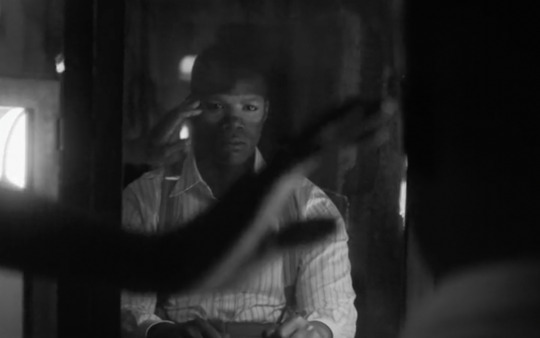
In the scene, we witness Will Reeves' transformation into one of the first black vigilante heroes in the world of "Watchmen." June convincing Will to conceal his racial identity mirrors the themes discussed by Fanon in "The Negro and Psychopathology." Fanon explores how Black individuals internalize negative stereotypes and struggle with their racial identity in the face of societal pressures. Will's efforts to conceal his race to gain acceptance as a hero resonate with Fanon's depiction of the psychological impact of racism on Black individuals. Will's struggle reflects the deep-seated societal norms and prejudices that force him to navigate a world where his identity is viewed as a barrier to acceptance and legitimacy. Through Will's journey, the episode highlights Fanon's insights into the internalized oppression experienced by Black individuals and the lengths to which they must go to navigate and resist oppressive systems.
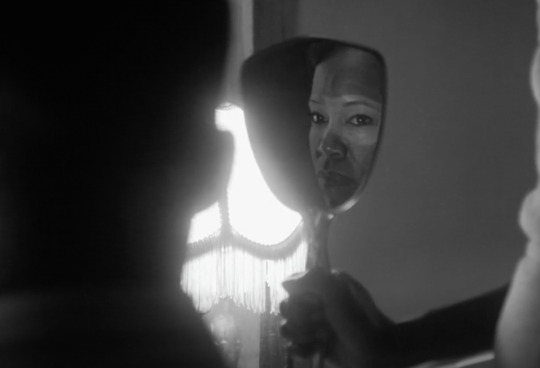
While Will is transforming into the Hooded Justice, June holds a mirror to Will's face, revealing the white paint of his vigilante mask. However, instead of seeing Will's reflection, we are confronted with Angela's gaze, adorned with the same paint. This visual shift symbolizes Angela's deep connection to her grandfather's struggles and the enduring legacy of oppression that transcends generations. The pain and racism Will endured, culminating in his transformation into the Hooded Justice, is shown not only to be an event of memories that Angela is experiencing through the drug Nostalgia, but as an inherited past for Angela, shaping her present-day fight for justice. In this way, Angela's journey becomes intertwined with her grandfather's, as both confront systemic racism and corruption within society. This echoes bell hooks' notion of women challenging harmful stereotypes, as Angela embodies the resistance against oppressive forces that seek to marginalize and diminish Black women's identities. Angela's ability to experience her grandfather’s legacy as the Hooded Justice allows her to understand her family’s history fighting against systemic racism and injustice, therefore giving her the power to then fight the same battle in present time, mirroring hooks' emphasis on empowerment and self-representation. Angela refuses to conform to societal expectations and instead takes control of her narrative, reclaiming her agency in the fight for justice. This aligns with hooks' advocacy for Black women to actively resist oppressive narratives and assert their own identities. Angela's journey, therefore, serves as a continuation of her grandfather's legacy, embodying the resilience and determination that hooks celebrates in Black women's resistance narratives.
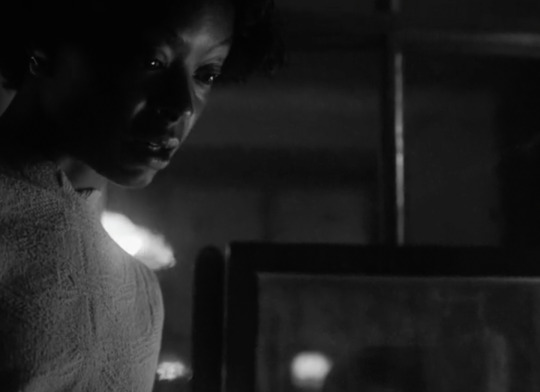
Although the scene is focused on Will Reeves, his wife June emerges as a shining figure, who becomes one of the few to demonstrate a deep understanding of the significance of his actions, particularly his decision to adopt the persona of the Hooded Justice. Rather than conforming to the stereotype of a passive housewife, June actively engages in pivotal moments and decisions alongside Will. Her active involvement, particularly in this scene, forces Will to confront his own motivations and provides a clear voice of reason in his life, serving as his main supporter in his fight against racial injustice and corruption. This portrayal aligns with Audre Lorde's concept of Black women in the media, as it challenges traditional stereotypes by depicting June as a strong, independent woman who plays a central role in shaping her husband's journey and confronting systemic oppression. Lorde argued that mainstream narratives often fail to acknowledge the diverse experiences and contributions of Black women, relegating them to narrow and limiting roles. June defies these constraints by actively participating in important decisions and conversations, challenging Will's perspectives, and providing crucial support in his fight against racial injustice and corruption. Her character serves as a powerful example of the strength, resilience, and agency inherent in Black women, aligning with Lorde's call for more nuanced and empowering representations in media.
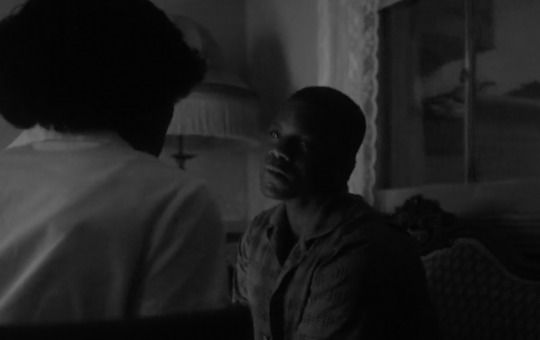
This scene serves as an overall commentary on the prevalent stereotypes that Black individuals encounter in mainstream media, echoing the sentiments expressed by Stam and Shohat regarding representation struggles. Will's evolution into Hooded Justice serves as a departure from traditional hero archetypes, presenting viewers with a new portrayal of heroism and justice. The scene touches into the intricacies of identity, shedding light on the formidable challenges faced by Will as he grapples with his concealing his racial identity within a predominantly white society in order to help them. This exploration underscores the complexities of serving a community that often marginalizes and rejects him, providing viewers with a strong portrayal of the systemic barriers and societal biases that Black individuals confront daily. In this context, the scene aligns with Stam and Shohat's advocacy for a media landscape that embraces diversity and inclusivity, emphasizing the need for narratives that accurately reflect the multifaceted experiences of marginalized communities.
The scene from “A God Walks into Abar” (00:17:30 - 00:20:50) depicts Angela assisting Jon in selecting a new identity from fallen soldiers, a moment that shows the themes explored in the four readings. Angela's decisive and proactive demeanor in guiding Jon's identity choice illustrates her strength as a character, echoing elements discussed in the readings. However, her apprehension in selecting a black body for Jon underscores the harsh reality of racial identity, highlighting the complexities and challenges faced by black individuals in society.

The internalization of negative stereotypes associated with being a black individual, a concept Fanon explores, was evident when Angela hesitated to present the body of Calvin Jelani, a black man, as a potential option for Jon to embody. Angela's hesitation to present Calvin Jelani's body as an option for Jon to embody reflects the concept explored by Fanon regarding the internalization of negative stereotypes associated with being black. This hesitation suggests Angela's awareness of the challenges and discrimination faced by black individuals in society, fearing that Jon, as a previously white man, might not fully grasp the complexities of racial identity. Moreover, Angela's concern for Jon's safety and the potential backlash he could face as a black man underscores the enduring racial tensions and injustices prevalent in their world. Angela's hesitation highlights her attempt to navigate the balance between protecting Jon and confronting the realities of racial identity, echoing Fanon's exploration of the psychological impact of racism on individuals.


Angela's role in formulating a strategy for Jon's integration into society using a deceased identity, coupled with her silent desire for him to adopt a black identity despite hiding it due to an awareness of the hardships faced by black individuals, illuminates her intelligence and profound awareness of societal dynamics. In this context, Angela's actions resonate with the insights offered by bell hooks and Audre Lorde, who delve into the intricate relationships between power, identity, and resistance. Angela's approach to navigating Jon's potential racial identity aligns with hooks' emphasis on the importance of self-awareness and critical consciousness in challenging oppressive systems. By recognizing the complexities of race and gender in societal structures, Angela demonstrates an awareness of the intersecting power dynamics that shape individual experiences. Angela's portrayal serves as a testament to the resilience and resourcefulness of black women, echoing hooks' vision of empowerment through critical engagement and resistance. Angela's contemplation of Jon's potential transformation into a black man also resonates with Audre Lorde's exploration of intersectional identities and the redefinition of difference. Lorde emphasizes the importance of recognizing and embracing differences among marginalized groups, advocating for collective action to resist oppressive systems based on race, gender, class, and sexuality. Angela's hesitation to present a black identity to Jon reflects Lorde's call to acknowledge the complexities of identity and the challenges faced by marginalized individuals. It underscores Lorde's assertion that difference should be embraced as a source of strength rather than a cause for separation. Through Angela's internal conflict, viewers are reminded of Lorde's vision of empowerment through self-awareness and collective struggle, highlighting the transformative potential of embracing diversity and difference in the fight against oppression.

Stam and Shohat's theory on media stereotypes sheds light on the tendency to reduce marginalized groups, particularly black individuals, to simplistic caricatures, perpetuating fixed and oversimplified images that fail to capture the richness of their experiences. In contrast, Watchmen stands out for its commitment to portraying the complexities of being black authentically. The scene featuring Angela's hesitation in selecting a black body for Jon serves as a prime example of the show's departure from these stereotypes. Rather than conforming to the trope of black characters as expendable or peripheral, Angela's contemplation acknowledges the weight of racial identity and the intricate historical context surrounding it. This refusal to succumb to stereotypes not only adds depth to the narrative but also underscores the show's commitment to challenging mainstream media's simplistic portrayals of race. Through its depiction of characters like Angela, Watchmen encourages viewers to engage critically with the multifaceted nature of identity, aligning with Stam and Shohat's call for more authentic representations of marginalized experiences in media narratives.

Conclusion:
Watchmen via the readings by Fanon, hooks, Lorde, and Stam and Shohat show how each of their themes and perspectives intersect and diverge in meaningful ways. The series navigates the complexities of race, gender, identity, and power dynamics, offering fresh portrayals that challenge stereotypes and invite viewers to critically engage with issues of representation and oppression. Through the scenes of Will Reeves becoming Hooded Justice and Angela assisting Jon in selecting a new identity, the show confronts the psychological and social repercussions of racism, sexism, and stereotyping of black individuals. These scenes resonate with Fanon's exploration of the internalization of negative stereotypes and the struggle for genuine self-realization, hooks' advocacy for critical viewing practices that resist oppressive narratives, Lorde's call for recognizing and embracing differences to confront oppressive systems, and Stam and Shohat's critique of oversimplified representations in media. The series acknowledges the complexities and challenges faced by black individuals but also empowers its characters to resist and redefine their identities in the face of systemic oppression.
Citations:
Frantz Fanon, "The Negro and Psychopathology," in Black Skin, White Masks, trans. Charles Lam Markmann (Grove Press, 1952), 113.
hooks, bell. "Oppositional Gaze: Black Female Spectators." In Black Looks: Race and Representation, 115-131. Boston, MA: South End Press, 1992. 311.
Lorde, Audre. "The Master's Tools Will Never Dismantle the Master's House." In Sister Outsider: Essays and Speeches by Audre Lorde, 110-113. Berkeley: Crossing Press, 2007, 110.
Shohat, Ella, and Robert Stam. "Stereotype, Realism, and the Struggle Over Representation." In Unthinking Eurocentrism: Multiculturalism and the Media, edited by Ella Shohat and Robert Stam, 277-309. London: Routledge, 1994, 214.
Frantz Fanon, "The Negro and Psychopathology," in Black Skin, White Masks, trans. Charles Lam Markmann (Grove Press, 1952), 115.
hooks, bell. "Oppositional Gaze: Black Female Spectators." In Black Looks: Race and Representation, 115-131. Boston, MA: South End Press, 1992. 308.
Lorde, Audre. "The Master's Tools Will Never Dismantle the Master's House." In Sister Outsider: Essays and Speeches by Audre Lorde, 110-113. Berkeley: Crossing Press, 2007, 111.
Lorde, Audre. "The Master's Tools Will Never Dismantle the Master's House." In Sister Outsider: Essays and Speeches by Audre Lorde, 110-113. Berkeley: Crossing Press, 2007, 115.
Shohat, Ella, and Robert Stam. "Stereotype, Realism, and the Struggle Over Representation." In Unthinking Eurocentrism: Multiculturalism and the Media, edited by Ella Shohat and Robert Stam, 277-309. London: Routledge, 1994, 182.
0 notes
Text
Analytical 6
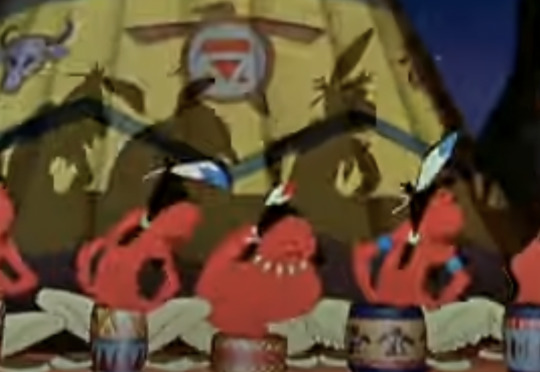
youtube
Stereotype
Shohat and Stam believe that when viewing how different ethnic or racial groups are shown in movies or TV, some only focus on stereotypes and how things are made to look real. They believe this method isn't always the best way because the reality of one person might not be the reality of someone else. They suggest the “task of the critic would be to call attention to the cultural voices at play, not only those heard in aural 'close-up' but also those distorted or drowned out by the text." (1)
In the scene from Peter Pan, the portrayal of Native Americans is steeped in stereotypes, an example of how harmful representations of marginalized groups are. The characters are adorned in exaggerated Native attire, complete with feathered headdresses, fringed garments, and moccasins, while the surroundings include teepee tents and accompanied by loud drumming, all designed to create an atmosphere meant to evoke a sense of exoticism and primitivism. What truly reveals the stereotype behind the portrayal is the depiction of the Native American characters themselves. Apart from the main Native American character Tiger Lily, who is portrayed as the beautiful love interest, the other Native American characters are depicted with negative stereotypes prevalent in Western media. These stereotypes manifest in several ways. First, the characters are depicted as excessively red, with their skin color exaggerated to an unnatural hue. This hyperbolic portrayal of their physical features, particularly the exaggerated redness of their skin, directly alludes to the derogatory term "redskins" commonly used to refer to Native Americans. This term, rooted in historical racism and violence against indigenous peoples, reduces complex and diverse cultures to a simplistic and dehumanizing caricature. To make matters more obvious, the song sung by the characters is quite literally labeled “What Made The Red Man Red'', further enforcing this negative and insensitive stereotype. The characters are also portrayed as loud and boisterous, with exaggerated mannerisms and speech patterns that further reinforce the stereotype of the "savage" or "uncivilized" Native American. The use of teepee tents and drums in the scene further reinforces these stereotypes, evoking images of a primitive and exotic “Other” that perpetuates harmful misconceptions about indigenous peoples. This scene shows Ella Shohat and Robert Stam's notion of stereotypes as cultural representations that essentialize and dehumanize marginalized groups. Stereotypes serve to reinforce power dynamics and uphold dominant narratives of superiority and inferiority. By reducing Native American identity to a narrow and distorted caricature, the scene in Peter Pan fails to capture the complexity and diversity of indigenous cultures. Instead, it perpetuates harmful myths and misconceptions that have long been used to justify colonialism, exploitation, and discrimination against indigenous peoples.

youtube
Orientalist Theory
Orientalist theory is a Western framework centered on the study, depiction, and control of the "Orient," particularly the Middle East and Asia. It's characterized by the belief that the "Orient" is fundamentally different from and inferior to the "Occident" (the West). This theory also asserts that the West possesses a superior capacity to objectively understand and analyze the Orient, which is often portrayed as irrational, depraved, and childlike. As cited by Said from Cromer, "The mind of the Oriental, on the other hand, like his picturesque streets, is eminently wanting in symmetry," (2) Orientalist theory views the Orient through a Eurocentric lens, reinforcing Western dominance and authority over the "Other."
In the scene from "Lady and the Tramp," the introduction of the Siamese cats serves as a prime example of Orientalist tropes. From the moment they appear on screen, their singing and foreign accents start to evoke an exotic atmosphere, which can be associated with their cultural associations with Asia, where Siamese cats are traditionally found. As they proceed to wreak havoc in the house, their actions are characterized by cunning and malevolence, traits often attributed to Orientalist depictions of the "Orient." The cats are even cartoonishly portrayed with narrow and slanted eyes, further exhibiting their “Asianness” to an extent. Their attempt to disrupt the peaceful environment by targeting the fish and disturbing the sleeping baby underscores the portrayal of the "Orient" as a source of menace or otherness in Western narratives. However, amidst their nefarious plans, Lady, the beautiful cocker spaniel, emerges as a symbol of Western intervention and order. By intervening to prevent the Siamese cats' mischief, Lady not only restores order to the household but also reaffirms Western dominance and control over the "Other." This dynamic reflects Orientalist theory, which posits the superiority of the West in understanding and managing the "Orient." Lady's intervention not only reinforces stereotypes about the "Other" but also perpetuates the narrative of Western hegemony, where the West is positioned as the savior and arbiter of order in the face of Oriental chaos.
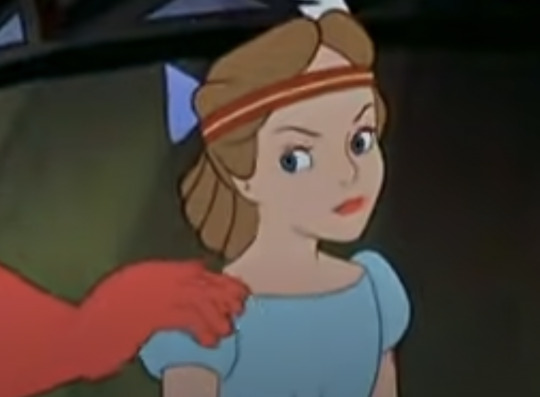
Eurocentrism
Eurocentrism refers to the tendency to view the world from a European or Western perspective, and to consider European culture, history, and values as the central and most important elements. This perspective often leads to the belief that European civilization is superior to other cultures and that non-European societies are inferior or "backward." As Edward Said states, "Orientalism is a style of thought based upon an ontological and epistemological distinction made between 'the Orient' and (most of the time) 'the Occident.'" (3) This Eurocentric worldview has been used to justify colonial domination, political and economic exploitation, and cultural assimilation of non-European peoples. Eurocentrism privileges the experiences and narratives of Europe and the West, while marginalizing or ignoring the histories, perspectives, and contributions of other civilizations around the world.
In the Native American scene from Peter Pan, where the Darling siblings and the Lost Boys are introduced and offered to join the Native Americans in celebration of Peter Pan and Tiger Lily, there is a distinct portrayal of Eurocentrism at play. The scene unfolds with an implicit sense of superiority and advancement that the white characters, represented by the Darling siblings and the Lost Boys, hold over the Native Americans. This dynamic is particularly evident in the interactions between one of the Native American women and Wendy Darling. Wendy, embodying Eurocentric values and perspectives, opposes many of the traditional aspects that the Native American woman tries to "enforce" upon her, indicating a dismissal or devaluation of the indigenous culture's customs and beliefs. This portrayal resonates with Edward Said's discussions on Orientalism and Eurocentrism. Orientalism, as Said describes it, involves a style of thought that creates a binary distinction between "the Orient" and "the Occident," with the latter being associated with superiority and advancement. In the scene from Peter Pan, the Eurocentric worldview is evident in the way the white characters, representing the Occident, assert their dominance and control over the Native Americans, depicted as the Orient. The rejection of indigenous traditions by Wendy and the implicit assumption of cultural superiority by the white characters reflect the Eurocentric belief that European civilization is superior to non-European cultures. The scene shows how Eurocentrism has been historically used to justify colonial domination, cultural assimilation, and exploitation of non-European peoples. By portraying the Native Americans as inferior or "backward," the scene reinforces the Eurocentric narrative of Western superiority and dominance. This not only perpetuates harmful stereotypes and misconceptions about indigenous peoples but also marginalizes their histories, perspectives, and contributions.

The Occident
Said discusses the concept of "the Occident '' in the context of Orientalism. According to the passage, "the Occident" refers to the West, Europe, or the Western world, in contrast to "the Orient" or the East. It notes that Orientalism involves the idea of Europe and "the notion that the real world is external to the observer, that knowledge consists of recording and classifying data-the more accurately the better" (4) - qualities associated with the Occident in contrast to the perceived characteristics of the Orient. Said argues that Orientalism creates a binary division between the Occident and the Orient, with the Occident depicted as rational, peaceful, and logical, in contrast to the Orient.
The Occident represents the Western world's perception of itself as superior to the Orient. In Lady and the Tramp, the portrayal of the Siamese cats reflects Said's idea of the Occident by perpetuating Orientalist stereotypes and perceptions of the East. The Siamese cats are depicted as cunning and manipulative, embodying Western notions of Oriental exoticism and deceit. Their accented voices, exaggerated Asian-like facial features, and disruptive behavior contribute to their characterization as the "Other," contrasting with the more familiar and relatable attributes of the film's Western characters. The Siamese cats' role as antagonists who disrupt the peaceful household of Lady and her owners reinforces Orientalist narratives of the Orient as a source of chaos and disruption in Western societies. Their attempt to wreak havoc in the household by targeting the fish and disturbing the baby reflects Orientalist perceptions of the East as inherently disruptive and irrational. Said argues that Western societies have historically constructed a binary opposition between the Occident and the Orient, with the former portrayed as rational, advanced, and civilized, while the latter is depicted as exotic, irrational, and inferior. This construction of the Orient as the "Other" serves to reinforce Western dominance and superiority.

youtube
Essentialism
Essentialism is the belief that things have a set of characteristics that make them what they are, and that these characteristics are innate and unchanging. The stereotype-centered approach to analyzing media representations can lead to a form of essentialism, as "less subtle critics reduce a complex variety of portrayals to a limited set of reified formulae." As the Shohat and Stam state, "Such reductionist simplifications run the risk of reproducing the very racial essentialism they were designed to combat." (5)
In "Dumbo," essentialism can be seen in the portrayal of the black crows and their initial disbelief in Dumbo's ability to fly. The black crows, voiced by African American actors and depicted with features associated with African American, like dialect, perpetuates essentialist stereotypes of black individuals as unintelligent and inferior. Their skepticism towards Dumbo's ability to fly can be seen as reflecting essentialist notions of fixed and unchanging characteristics associated with race, suggesting that black characters are inherently limited by their perceived lack of intelligence and capabilities. The black crows' portrayal as uneducated and ignorant reinforces essentialist stereotypes of African Americans as intellectually inferior and socially disadvantaged. Their initial dismissal of Dumbo's potential reflects broader essentialist narratives of racial inferiority and reinforces the idea that individuals are defined by their race and incapable of transcending these perceived limitations. Also, the scene's depiction of the black crows as comedic and lighthearted characters can be viewed as further perpetuating essentialist stereotypes of black individuals as entertainers or comic relief, rather than fully developed and complex characters. By reducing the black crows to one-dimensional caricatures, the film reinforces essentialist perceptions of race and limits the representation of African American characters to stereotypical roles.
The crows' initial disbelief in Dumbo's ability to fly can also be viewed through an essentialist lens shaped by stereotypes associated with elephants. As the crows encounter Dumbo, they immediately dismiss the idea of an elephant flying, reflecting essentialist perceptions of elephants as large, heavy creatures incapable of feats such as flight. This essentialist view is influenced by stereotypes that define elephants solely by their physical characteristics and traditional behaviors, such as their perceived inability to fly. The crows' skepticism towards Dumbo's potential can also be seen as a manifestation of broader essentialist narratives that limit individuals based on perceived characteristics associated with their race or species. The crows' reaction to Dumbo reflects essentialist perceptions of intelligence and capabilities, as they judge Dumbo based on preconceived notions rather than his individual traits or potential. This essentialist perspective contributes to the marginalization of Dumbo and reinforces broader narratives of inequality and discrimination.
Citations
Shohat, Ella, and Robert Stam. "Stereotype, Realism, and the Struggle Over Representation." In Unthinking Eurocentrism: Multiculturalism and the Media, edited by Ella Shohat and Robert Stam, 277-309. London: Routledge, 1994, 214.
Said, Edward W. Orientalism. New York: Vintage Books, 1979, 46.
Said, Edward W. Orientalism. New York: Vintage Books, 1979, 10.
Said, Edward W. Orientalism. New York: Vintage Books, 1979, 54.
Shohat, Ella, and Robert Stam. "Stereotype, Realism, and the Struggle Over Representation." In Unthinking Eurocentrism: Multiculturalism and the Media, edited by Ella Shohat and Robert Stam, 277-309. London: Routledge, 1994, 199.
0 notes
Text
Analytical Application 3
Simulation

Baudrillard defines simulation as the replacement of the real with its signs and models, where the distinction between reality and its representation breaks down. He argues that in the modern world, reality is no longer reflected by images, but by images that have become their own reality. Simulation is the fourth stage of the image, where it "bears no relation to any reality whatever: it is its own pure simulacrum."(1) Simulation can become detached from reality, leading to the proliferation of hyperreal experiences. For Baudrillard, simulation is a fundamental characteristic of postmodern society, where the real is concealed by an endless play of signs and models that have become more real than reality itself.
In Run Lola Run, simulation emerges prominently through the film's narrative structure and stylistic choices, particularly in the cartoon scene, a brief animated sequence that occurs during Lola's second run. This scene transitions from the live-action format in Lola’s living room into a stylized cartoon rendition through her TV, portraying Lola's frantic rush to the store. (Tykwer, 1999, 00:35:10) The animated sequence shows and captures the intensity and urgency of Lola's mission, featuring exaggerated movements and surreal visuals that diverge from the film's established reality. As Lola descends the stairs, the animated frames convey a sense of wildness and anxiety, creating a distinct reality detached from the rest of the film. However, this hyperreal experience is abruptly interrupted when Lola trips at the bottom of the stairs, breaking the spell and returning the narrative to its primary reality. This moment shows Baudrillard's concept of simulation, where the boundary between reality and its representation collapses. The animated sequence becomes its own self-contained reality, coexisting alongside, yet separate from, the film's overarching narrative. By blurring the boundaries between authentic reality and hyperreal representation, Run Lola Run offers an exploration of perception and the influence of simulation in society and represents the ways in which simulation shapes our understanding of the world.
Parody

Jameson defines parody as the "imitation or, better still, the mimicry of other styles and particularly of the mannerisms and stylistic twitches of other styles." He explains that parody "capitalises on the uniqueness of these styles and seizes on their idiosyncrasies and eccentricities to produce an imitation which mocks the original." (2) Jameson believes that for parody to be effective, there needs to be an underlying appreciation for the original source.
In Run Lola Run, the cartoon scene where Lola transforms into a cartoon character rushing down the stairwell in the second rendition of the loop can be interpreted as a form of parody. (Tykwer, 1999, 00:35:15) Fredric Jameson's definition of parody as the mimicry of other styles finds resonance in this sequence. It serves as a fun departure from the film's live-action format, offering an almost humorous imitation of traditional animated storytelling while injecting a sense of self-awareness into the narrative. The cartoon scene parodies the conventions of live-action cinema by juxtaposing Lola's animated character with the film's mostly live-action setting. A lot of what Lola does throughout the film is motivated by her time constraint. The film elevates this time constraint in the cartoon rendition of her rush to leave the apartment complex in an exaggerated and mischievous way, particularly in the mannerisms of all the characters. For example, the man with the dog and his smile before he sticks out his foot to trip Lola was animated to be very specific and humorous in a way. Lola's transformation into a cartoon character during her second run mimics her real-life mannerisms using animation but also exaggerates her movements and actions in a way that feels both familiar and distinctly different from the film's live-action sequences. This not only adds a unique depth to Lola's journey but also offers a playful nod to the repeated sequence using a traditionally childish style of animation. Through this parodic element, Run Lola Run chooses to engage with established cinematic tropes in a fun and creative way.
Repetition

Deleuze says repetition is a singular power that differs from generality. Repetition is not really about exchanging or substituting one particular for another, but rather when repetition happens it concerns something unique and irreplaceable. It is a conduct and point of view that relates to the "non-exchangeable and non-substitutable singularities." Repetition "interiorizes and thereby reverses itself" - it does not simply add more instances, but rather carries the first instance to the "nth power." (3) Deleuze contrasts repetition with the generality of laws, which compel subjects to change and illustrate the law, rather than enabling true repetition.
Gilles Deleuze's concept of repetition in Run Lola Run is the center of the film's narrative structure, where events recur with slight variations, showing a transformative process rather than a simple duplication. Each iteration of Lola's journey to save Manni represents a new possibility influenced by her choices and actions. For example, in the first loop, Lola runs by someone with a dog, and the audience is not drawn to this moment as much. However, in the second loop, Lola runs past the same person and he trips her (Tykwer, 1999, 00:35:23), causing her to run with a limp and results in her arriving late to the bank, causing a cascade of different events. This cyclical narrative approach allows the film to explore the fluidity of time and the interconnectedness of cause and effect. Deleuze's notion of repetition as a creative force aligns with the film's thematic exploration of fate, chance, and the dynamic interplay between individual agency and external forces. In Run Lola Run, repetition serves as a mechanism for change and divergence, highlighting the potential for small alterations to lead to significant shifts in the narrative trajectory. The film's repetitive structure challenges traditional notions of linear progression, inviting viewers to contemplate the complexities of choice and consequence. Through Lola's repeated attempts to alter the course of events, Run Lola Run offers a thought-provoking meditation on the nature of reality, the power of free will, and the multiplicity of potential outcomes that exist within the realm of possibility. Deleuze's conception of repetition in the film shows its exploration of the interplay between chance and determinism, and overall emphasizes the transformative consequences in every choice and action.
Resemblance

According to Deleuze, resemblance is different from repetition. Resemblance belongs to the "order of generality," which is characterized by two major orders: the qualitative order of resemblances and the quantitative order of equivalences. Generality "expresses a point of view according to which one term may be exchanged or substituted for another." (4) While resemblance allows for the exchange and substitution of particulars, repetition is allowed when there's no other choice. Resemblance refers to the similarity or likeness between entities or representations. In Deleuze's framework, resemblance emerges from the repetition of differences, leading to the formation of general patterns or structures.
In Run Lola Run, resemblance within the repeated scenarios Lola faces as she tries to save Manni. Each iteration of her journey to save Manni at the store bears resemblance to the previous ones, with similar settings, characters, and events. Despite slight variations in Lola's actions and decisions, there is a fundamental resemblance in the overall structure of her attempts. While repetition can be found in the cyclical nature of Lola's attempts to save Manni, Delueze’s idea of resemblance encompasses the overarching similarities between these iterations. Repetition emphasizes the recurrence of specific events and scenarios, with Lola experiencing similar challenges and obstacles in each run. On the other hand, resemblance highlights the broader thematic and structural similarities that persist throughout the film. These resemblances include scenes when Lola encounters the same characters and situations during each of her runs, despite slight variations in her actions and decisions. One example is Lola's interactions with the woman and her stroller. In each iteration of her journey, Lola encounters the woman and her stroller on the street, and their interactions unfold similarly, with Lola running past the woman and the woman throwing insults at her (Tykwer, 1999, 00:36:20). Despite the repetition of this encounter, there is a resemblance in the overall dynamic and outcome of the interaction, highlighting the interconnectedness of Lola's experiences and the recurring themes of chance and fate throughout the film. This scene exemplifies how Run Lola Run uses resemblance to create a sense of continuity and coherence within the narrative, despite the repeated sequences and variations in Lola's journey. Resemblance emphasizes the underlying coherence and consistency that link the different runs together. In essence, resemblance serves to underscore the film's thematic unity and interconnectedness, while repetition highlights the cyclical nature of Lola's quest and the idea of multiple possibilities existing within a singular framework.
Nostalgia Mode

The nostalgia mode in postmodernism involves the imitation or mimicry of past styles and mannerisms, but without the "satirical impulse" or "sense of humor" of parody. Jameson describes this as "pastiche", which he defines as "blank parody, parody that has lost its sense of humor". (5) The rise of pastiche reflects the "death of the subject" or the end of individualism. In today's world, where everything is divided and focused on profit, it results in no room for the unique personal styles of artists.
The film creatively engages with and pays homage to many stereotypical tropes of cinema while also offering a unique twist on these conventions, particularly in the thriller genre. This homage to cinematic tropes can be related to Fredric Jameson's concept of nostalgia mode, where past styles and mannerisms are imitated without the satirical impulse of parody. Run Lola Run distinguishes itself by infusing these tropes with innovative storytelling techniques, particularly with the cyclical nature of the film. One instance of homage to cinematic tropes is the film's use of split-screen techniques (Tykwer, 1999, 00:59:30). The film uses the split screen to convey the simultaneous reactions and point of views from multiple different characters, like Manni and Lola or Lola and her father. This technique, popularized in classic cinema, is used to depict parallel events or emphasize the interconnectedness of characters and scenarios. In Run Lola Run, split-screen sequences are used to convey multiple perspectives within a single frame, adding visual dynamism and narrative complexity to the story. However, the film's use of split-screen is not merely a nostalgic nod to classic cinema but rather a creative tool to enhance the storytelling and engage the audience in new and unexpected ways.
Citations
Baudrillard, Jean. "Simulacra and Simulations." In Selected Writings, edited by Mark Poster, 166-184. Stanford, CA: Stanford University Press, 1988, 153.
Jameson, Fredric. "Postmodernism and Consumer Society." In The Cultural Turn: Selected Writings on the Postmodern, 1983-1998, edited by Frederic Jameson, 200-221. London: Verso, 1998, 166.
Deleuze, Gilles. "Introduction: Repetition and Difference." In Gilles Deleuze: Essays Critical and Clinical, edited by Daniel W. Smith and Michael A. Greco. Minneapolis: University of Minnesota Press, 1997, 1.
Deleuze, Gilles. "Introduction: Repetition and Difference." In Gilles Deleuze: Essays Critical and Clinical, edited by Daniel W. Smith and Michael A. Greco. Minneapolis: University of Minnesota Press, 1997, 1.
Jameson, Fredric. "Postmodernism and Consumer Society." In The Cultural Turn: Selected Writings on the Postmodern, 1983-1998, edited by Frederic Jameson, 200-221. London: Verso, 1998, 167.
0 notes
Text
Said, Shohat, and Stam offer different perspectives on how race and representation is portrayed in the media. Said's "Orientalism" and Shohat and Stam's "Stereotype, Realism, and the Struggle Over Representation" show how dominant narratives in film and popular culture encourage stereotypes and reinforce power dynamics and reveal links between orientalism and media, how it intensifies cultural stereotyping and its effect on representation, and the potential for film and television to challenge misrepresentation.
Said’s idea of Orientalism is that the Western construction of the "Orient" is exotic, mysterious, and inferior. This gaze influenced depictions of Eastern cultures in film, which only enforced stereotypes and power imbalances. Orientalism is the way Westerners think in that “based upon an ontological and epistemological distinction made between 'the Orient' and (most of the time) 'the Occident.'” (1)
The standardization and cultural stereotyping prevalent in film, television, and popular media have intensified the demonization of the "mysterious Orient", reducing it to a simple entity instead of the rich and diverse culture and society that they are.
Shohat and Stam show the role of stereotypes in shaping the representation of people in film and television, and how they can perpetuate harmful narratives about marginalized communities. They also emphasize the ability of visual media to challenge and disrupt these stereotypes. By making deliberate representation choices, filmmakers can subvert stereotypes and offer real and genuine portrayals of diverse communities, challenging dominant narratives and encouraging true representation for many cultures, but also need to extend beyond just identifying the “errors” in representation. “Debates about ethnic representation often break down on precisely this question of "realism," at times leading to an impasse in which diverse spectators or critics passionately defend their version of the "real.” (2) By centering the voices and experiences of underrepresented groups, film and television have the power to reshape perceptions of cultural misrepresentation and contribute to a more inclusive and equitable cultural landscape.
These readings highlight the influence of race and representation on visual media, but by analyzing orientalism and stereotypes in film, television, and popular culture, we can strive for a more inclusive cultural sphere that embraces diversity and confronts entrenched power structures.
Citations
Said, Edward W. Orientalism. New York: Vintage Books, 1979, 10.
Shohat, Ella, and Robert Stam. "Stereotype, Realism, and the Struggle Over Representation." In Unthinking Eurocentrism: Multiculturalism and the Media, edited by Ella Shohat and Robert Stam, 277-309. London: Routledge, 1994, 178.
Reading Notes 10: Said to Shohat and Stam

To wrap up our studies of visual analysis, Edward W. Said’s “Orientalism” and Ella Shohat and Robert Stam’s “Stereotype, Realism, and the Struggle Over Representation” provide critical paths to understanding the roles of race and representation play in our production and consumption of film, television, and popular culture.
How is orientalism linked to film, television, and popular media, and in what ways has standardization and cultural stereotyping intensified academic and imaginative demonology of “the mysterious Orient” in these mediums?
What role do stereotypes play in the representation of people, and in what ways can film and television change the perception of cultural misrepresentation?
@theuncannyprofessoro
15 notes
·
View notes
Text
Halberstam's "Looking Butch: A Rough Guide to Butches on Film" and Hall's "What is this 'Black' in Black Popular Culture?" provide an examination of how marginalized identities are portrayed in both positive and negative ways in the media.
Halberstam's exploration of butch representation in film offers insights into how marginalized gender identities are portrayed and perceived in popular media. While there have been instances of positive representations that challenge gender norms and celebrate diversity, such as characters in films like "Boys Don't Cry" or "But I'm a Cheerleader," these portrayals can also reinforce stereotypes and contribute to the marginalization of butch identities. Halberstam believes “stereotyping does not always and only work on behalf of a conservative representational agenda: the stereotype does often represent a "true" type, a type, in other words, that does exist within the subculture", (1) and ultimately perpetuates harmful stereotypes about gender nonconformity.
Similarly, Hall's analysis of Black popular culture sheds light on the ways in which racial identities are constructed and contested in media representations. Hall argues that while there have been efforts to celebrate Blackness in popular culture, these representations often reflect and perpetuate dominant power structures, because “black popular culture is a contradictory space. It is a sight of strategic contestation. But it can never be simplified or explained in terms of the simple binary oppositions that are still habitually used to map it out: high and low; resistance versus incorporation; authentic versus inauthentic, experiential versus formal; opposition versus homogenization.” (2) Positive images of Blackness may serve to humanize and empower Black individuals, but they can also reinforce racial stereotypes and uphold systems of oppression. For example, Hall highlights the prevalence of stereotypes such as the "magical Negro" or the "dangerous Black criminal," which limit the complexity and diversity of Black experiences.
Halberstam and Hall's analyses highlight the complexities of representation in popular culture and how it emerges as a complicated place where various identities are negotiated, performed, and contested. Cultural representations reflect the power dynamics of society, shaping how marginalized communities are perceived and treated. However, cultural strategies have the potential to challenge these narratives and shift the balance of power. By amplifying diverse voices, challenging stereotypes, and advocating for more inclusive representations, activists and artists can work towards creating a more equitable and just cultural landscape.
Citations
Halberstam, Jack. "Looking Butch: A Rough Guide to Butches on Film." In The Lesbian and Gay Studies Reader, edited by Henry Abelove, Michele Aina Barale, and David M. Halperin, 237-249. Chicago: University of Chicago Press, 1993, 180.
Hall, Stuart. "What is this ‘Black’ in Black Popular Culture?" In Black Popular Culture: A Project by Michele Wallace, edited by Gina Dent, 21-33. Seattle: Bay Press, 1992, 473.
Reading Notes 9: Halberstam to Hall

Jack Halberstam’s “Looking Butch: A Rough Guide to Butches on Film” and Stuart Hall’s “What is this ‘Black’ in Black Popular Culture?” link our inquiries into gender and sexuality with race and representation.
What examples of “positive images” of marginalized peoples are in film and television, and how can these “positive images” be damaging to and for marginalized communities?
In what ways is (popular/visual) culture (performance) a complicated and political site where various identities are negotiated, and how can cultural strategies make a difference and shift dispositions of power?
@theuncannyprofessoro
15 notes
·
View notes
Text
Analytical Application 5

Scopophilia
For Mulvey, scopophilia is when pleasure is derived from looking at another person as a sexual object. In film, cinema satisfies this "primordial wish for pleasurable looking" (1) by presenting the human form as the object of the spectator's gaze. The scopophilic pleasure is mixed with narcissistic identification because the spectator projects their own ego ideal onto the image on the screen. Mulvey argues that this idea of scopophilia is central to the pleasure and power structures of mainstream narrative cinema.
On page 429, the narrative unfolds within the realm of Dreams, where Rose finds herself having to give up her heart to her grandmother in order to thwart the vortex that threatens to unravel reality itself. As Rose reaches towards the physical embodiment of her heart, which is the very power of the vortex, the artist and reader chooses to make an artistic choice by illustrating an exposed breast across several panels, which only adds an unnecessary sexual element into the scene. This artistic decision encompasses Laura Mulvey's concept of scopophilia. According to Mulvey, the male gaze is often manifested through the objectification and sexualization of female characters, serving to satisfy the desires of the viewer. In this instance, the portrayal of Rose's vulnerability and the sexualized imagery within the Dream realm directly aligns with Mulvey's theories. It reflects a pattern wherein creators consistently sexualize Rose, presenting her in ways that cater to the presumed desires of the audience. What adds a layer of irony to this portrayal is its occurrence within the realm of Dreams itself. Within this realm, creators have unparalleled freedom to explore and manifest their subconscious desires. Thus, the sexualization of Rose within this space mirrors not only the desires of the creators but also their fantasies and projections about women. The Dream realm becomes a reflection of the creators' own dreams and the fulfillment of their desires, further reinforcing Mulvey's observations about the objectification of female characters within media.
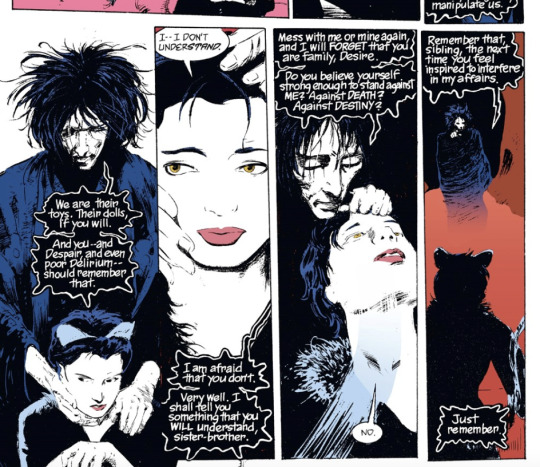
Queer Gaze
Judith Butler idea of the concept of the ‘queer gaze’ is that the camera and filmmaker's gaze in a film can be seen as "an instrument and effect of lesbian desire", which "trades on the masculine privilege of the disembodied gaze, the gaze that has the power to produce bodies, but which is itself no body". (2) She argues that this gaze provides a perspective that challenges heteronormative conventions and offers alternative ways of seeing and interpreting visual representations, particularly in relation to gender and sexuality, and overall underscores how the queer gaze can subvert hegemonic norms of gender, race, and sexuality.
In The Sandman on page 438, a confrontation unfolds between Dream and Desire, delving into the Desire’s ominous schemes to mess with Dream’s affairs and issue a vortex. Desire is depicted as a captivating, nonbinary entity, with feline allure throughout their interactions with Dream. What's interesting about Desire's portrayal is its fresh representation of nonbinary identity. Rather than reducing Desire to a mere stereotype or making their nonbinary identity the sole focus, the narrative presents them as a multifaceted character wielding significant power. We see them as an extremely desirable and sensual character, especially as the literal embodiment of the concept of Desire itself. Having Desire be non-binary/genderfluid encompasses the idea that Desire is amongst everyone, and takes on whatever form it pleases. It also imbues real life non-binary people with a powerful representation of a character, providing a new perspective and subverting typical hegemonic norms of gender and sexuality.
This approach aligns with Judith Butler's concept of the queer gaze, which challenges conventional heteronormative norms, by portraying nonbinary individuals in the novel as desirable and authoritative without essentializing their identity. By showcasing Desire in this manner, "The Sandman'' offers a new perspective on how nonbinary people can be depicted in fiction. It recognizes their complexity and agency while avoiding tokenization or reducing them to their gender identity alone. Instead, Desire's character serves as a compelling embodiment of the fluidity and ambiguity inherent in nonbinary experiences, enriching the narrative with layers of intrigue and depth.
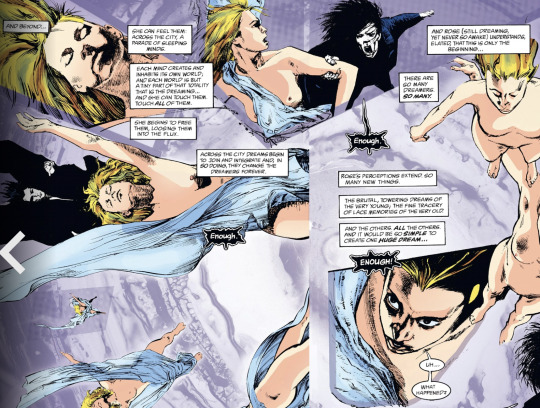
To-Be-Looked-At-Ness
According to Mulvey, "to-be-looked-at-ness" refers to the way women are represented in cinema as passive objects of the male gaze and are coded for strong visual and erotic impact. Mulvey argues that "the determining male gaze projects its phantasy on to the female figure which is styled accordingly. In their traditional exhibitionist role women are simultaneously looked at and displayed, with their appearance coded for strong visual and erotic impact so that they can be said to connote to-be-looked-at-ness." (3) The objectification of the female form serves to satisfy the scopophilic desires of the male spectator while also denying women's subjectivity and agency within the narrative.
In "The Sandman," Rose realizes her innate ability to influence and reshape dreams, and even alter reality itself. As she begins to unravel the fabric of dreams, her newfound power manifests visually, symbolized by her ethereal presence and the gradual shedding of her blue silk robe, revealing her naked form across successive panels on page 408. This sequence can be seen as not just merely a visual device but a complex interplay of symbolism and thematic exploration. While there is a metaphorical resonance between Rose's unraveling robe and the idea of her discovering her power over dreams, the explicit portrayal of her nakedness is questionable. The portrayal of Rose's naked body, fragmented across panels, implicates viewers in what Laura Mulvey terms "to-be-looked-at-ness," wherein the female character is objectified for the gaze of the spectator. Within the Dream realm, Rose is frequently subject to these naked portrayals and is constantly exposed. Despite her apparent power and status in the realm, it feels as if the artist disregards this and chooses to portray her in a vulnerable and erotic state for the pleasure of the viewer, particularly appealing to men. Rose's vulnerability and exposure serve as a visual metaphor for the scrutiny and objectification often imposed upon female characters in visual media. However, it's crucial to interpret this scene within the broader context of the narrative. Rose's unraveling signifies not just vulnerability but also agency and empowerment as she asserts control over the realm of dreams.

Phallocentric Spectatorship
According to Mulvey, the concept of phallocentric spectatorship is the way mainstream cinema is structured around a male gaze that objectifies women as passive objects of visual pleasure. Mulvey argues that women are “bound by a symbolic order in which man can live out his phantasies and obsessions through linguistic command by imposing them on the silent image of woman still tied to her place as bearer of meaning, not maker of meaning” (4). This male gaze denies women's subjectivity and agency, positioning them as objects for the controlling, voyeuristic look of the male spectator. Mulvey sees this phallocentric structure of spectatorship as a key aspect of the patriarchal ideology that highlights how narratives and images often reinforce and uphold male dominance and authority.
In the tale of Dream's first true love for Nada, the dynamics of power, agency, and gender roles intertwine in this short story. Dream's offer of companionship to Nada, as the Queen of dreams, initially appears as a gesture of affection and admiration. However, Nada, burdened by her own sense of unworthiness and the fear of her potential influence leading the world into darkness, refuses his proposition, and even jumps to her death. Despite Nada's rejection, Dream persists, repeatedly asking her to be his bride. In this persistent pursuit, Dream's dominance becomes evident, overshadowing any genuine choice for Nada, particularly as a woman in a primitive, patriarchal society. Dream's perception of Nada primarily as a bride and a potential Queen underscores the imbalance of power in their relationship, where his desires and perceptions take precedence over her individual autonomy. The panels on page 248 show the true nature of this dilemma, as Nada confronts the weight of eternal damnation should she continue to refuse Dream's advances. Her acknowledgment of the consequences underscores the coercive nature of Dream's affection, further accentuating the imbalance of power inherent in their dynamic. While she had the ability to recognize and accept her damned future when Dream asked again, Dream’s clear coercive nature makes the male dominance and authority evident within the panels. This narrative aligns with Mulvey's concept of phallocentric spectatorship, wherein the male gaze dominates and objectifies female characters, reducing them to objects of desire and reinforcing traditional gender roles. Nada's agency is subverted by Dream's relentless pursuit, which shows the true influence of patriarchal norms within the narrative framework. Thus, while Dream's love for Nada seemed to be genuine, it was ultimately tainted by the unequal power dynamics and societal expectations that governed their interactions.
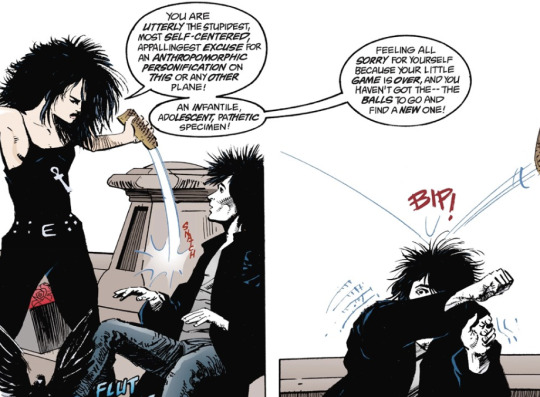
Subversion
According to Mulvey, the concept of subversion in relation to the male gaze and female representation in film surrounds disrupting traditional patriarchal structures that objectify women on screen. Mulvey argues that "the paradox of phallocentrism in all its manifestations is that it depends on the image of the castrated woman to give order and meaning to its world". (5) By "destroying pleasure" and "destroying the satisfaction" derived from the voyeuristic and fetishistic gaze, women can challenge the dominant ideology that positions women as passive objects of the male spectator's desire. Mulvey's notion of subversion centers on destabilizing the normative visual pleasure associated with the cinematic apparatus and the male gaze.
Death, depicted as the sister of Dream, exudes grace, spunk, and kindness, redefining the conventional perception of death on page 209. What really makes this significant is the fact that the portrayal of Death is a formidable female entity, diverging from the previous prevalent male personifications across cultures. Beyond her gender, she embodies traits of autonomy and personality, offering counsel and assistance to Dream amidst hard circumstances. This depiction aligns with Mulvey's notion of subversion, where established norms and expectations are challenged. Death's characterization challenges the traditional patriarchal dominance associated with the concept of death. Her presence not only defies gender stereotypes but also imbues death with a sense of compassion and understanding, contrasting with its typically feared and somber portrayal. By intertwining Death's character with agency and depth, the narrative subverts gender roles and offers a new perspective on mortality. Death's collaboration with Dream not only shows the importance of mutual support and cooperation, but we also see her knowing more and holding the role of an older, more powerful being, transcending traditional power dynamics. This portrayal resonates with Mulvey's idea of subversion, as it challenges established narratives and offers alternative interpretations that defy societal norms.
Citations
Laura Mulvey, “Visual Pleasure and Narrative Cinema,” in Visual and Other Pleasures (Bloomington: Indiana University Press, 1989), 714.
Judith Butler, “Gender is Burning: Questions of Appropriation and Subversion,” in Bodies That Matter: On the Discursive Limits of “Sex” (New York: Routledge, 2011), 347.
Laura Mulvey, “Visual Pleasure and Narrative Cinema,” in Visual and Other Pleasures (Bloomington: Indiana University Press, 1989), 715.
Laura Mulvey, “Visual Pleasure and Narrative Cinema,” in Visual and Other Pleasures (Bloomington: Indiana University Press, 1989), 712.
Laura Mulvey, “Visual Pleasure and Narrative Cinema,” in Visual and Other Pleasures (Bloomington: Indiana University Press, 1989), 711.
0 notes
Text
Lorde and Butler both explore power, privilege, and gender performativity. They question how power structures shape relationships and institutional dynamics, and also highlight the complexities of gender norms and heterosexuality as performances.
Power and privilege influence interactions among individuals and institutions, perpetuating systems of oppression and marginalization. Lorde's work emphasizes the futility of using oppressive systems to combat oppression, advocating instead for the creation of alternative frameworks. She believes that “difference must be not merely tolerated, but seen as a fund of necessary polarities between which our creativity can spark like a dialectic. Only then does the necessity for interdependency become unthreatening. Only within that interdependency of different strengths, acknowledged and equal, can the power to seek new ways of being in the world generate, as well as the courage and sustenance to act where there are no charters.” (1), arguing that only when we acknowledge and value the diversity of strengths among individuals can we truly realize the potential for collaborative interdependence. By recognizing and treating each other's strengths as equal, we create a foundation for mutual support and cooperation. Butler's examination of gender performativity underscores how cultural, societal, and media representations reinforce and complicate gender norms, and that someone “who appears not to be in a condition of trespass prior to the call (for whom the call establishes a given practice as a trespass) is not fully a social subject, is not fully subjectivated, for he or she is not yet reprimanded. The reprimand does not merely repress or control the subject, but forms a crucial part of the juridical and social formation of the subject." (2) This highlights heterosexuality as a socially constructed performance rather than an inherent identity. By acknowledging, examining, and remedying oppression within marginalized systems, we can disrupt existing power dynamics and foster more inclusive environments.
Through Lorde and Butler, we can conclude that power and privilege shape our experiences and understandings of gender and sexuality, but by critically engaging with oppressive structures and embracing alternative frameworks, we can work towards dismantling systems of oppression and creating more equitable societies.
Citations
Lorde, Audre. "The Master's Tools Will Never Dismantle the Master's House." In Sister Outsider: Essays and Speeches by Audre Lorde, 110-113. Berkeley: Crossing Press, 2007, 111.
Butler, Judith. "Gender is Burning: Questions of Appropriation and Subversion." In Bodies That Matter: On the Discursive Limits of "Sex," 15-44. New York: Routledge, 2011, 336.
Reading Notes 8: Lorde to Butler
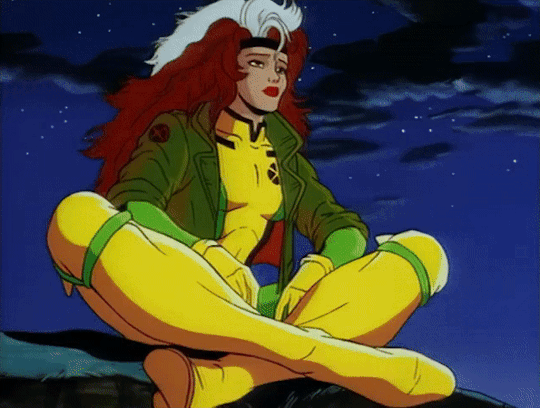
In our continued discussions, Audre Lorde’s “The Master’s Tools Will Never Dismantle the Master’s House” and “Age, Race, Class, and Sex: Women Redefining Difference,” and Judith Butler’s Gender is Burning: Questions of Appropriation and Subversion” provide further introspection into systems and definitions of gender and sexuality.
How do power and privilege impact the relations people have with each other and with institutions, and how can we acknowledge, examine, and remedy oppression and marginalization using oppressive and marginalized systems?
How do cultural, societal, and media representations support gender performativity and in so doing complicate gender norms, and in what ways is heterosexuality a performance?
@theuncannyprofessoro
17 notes
·
View notes
Text
Mulvey's "Visual Pleasure and Narrative Cinema" and Hooks's "Oppositional Gaze: Black Female Spectators," offer persectives on the nature of different types of spectatorship and cinematic representation. Mulvey's analysis focuses on the concept of the male gaze and its reinforcement of patriarchal power structures within mainstream cinema, while hooks introduces the oppositional gaze as a means for marginalized viewers, particularly black women, to resist and subvert dominant narratives. Through these readings we gain insight into the complexities of viewing pleasure, the influence of social identities, and the potential for resistance within cinematic spaces.
Mulvey argues that traditional Hollywood cinema positions the viewer as male and the object of desire as female, creating a voyeuristic dynamic where women are objectified and passive, and where “pleasure in looking has been split between active/male and passive/female”. (1) This perpetuates patriarchal norms and reinforces gender power imbalances. In contrast, hooks introduces the oppositional gaze, which empowers black female spectators to critically engage with mainstream media representations and emerge “ as a site of resistance only when individual black women actively resist the imposition of dominant ways of knowing and looking.” (2) By resisting the dominant gaze, marginalized viewers reclaim agency and challenge hegemonic ideologies.
Mulvey's theory show us mechanisms of patriarchal domination within cinema, while hooks's oppositional gaze offers a framework for resistance and empowerment against those dominant ideologies. They nvite us to critically examine the power dynamics at play in cinematic representation and explore alternative modes of spectatorship that challenge dominant ideologies and narratives.
Bibliography
Mulvey, Laura. "Visual Pleasure and Narrative Cinema." In Visual and Other Pleasures, 14-26. London: Macmillan, 1989. 715.
hooks, bell. "Oppositional Gaze: Black Female Spectators." In Black Looks: Race and Representation, 115-131. Boston, MA: South End Press, 1992. 317.
Reading Notes 7: Mulvey to hooks

Shifting our visual analysis and critical inquiries to gender and sexuality, we will begin our explorations with Laura Mulvey’s “Visual Pleasure and Narrative Cinema” and bell hooks’s “Oppositional Gaze: Black Female Spectators.”
How does the spectacle of the female image relate to patriarchal ideology, and in what ways do all viewers, regardless of race or sexuality, take pleasure in films that are designed to satisfy the male gaze?
How do racial and sexual differences between viewers inform their experience of viewing pleasure, and in what ways does the oppositional gaze empower viewers?
@theuncannyprofessoro
16 notes
·
View notes
Text
Analytical Application 4
The uncanny refers to something that is familiar but strange to the point where it evokes a sense of unease or discomfort. Freud describes the uncanny as "that class of the terrifying which leads back to something long known to us, once very familiar". (1) He explains that the uncanny arises when "repressed infantile complexes have been revived by some impression, or when the primitive beliefs we have surmounted seem once more to be confirmed". The uncanny is associated with the return of something that was once known but has since been repressed or forgotten, creating a sense of unsettling familiarity.
At the conclusion of the episode, we encounter Eugene Victor Tooms, the serial killer, confined within a cell. Inside, he initiates the construction of a new hibernation nest using newspapers, intending to slumber for another three decades. The agents discuss the genetic tests that they had done on Tooms, and reveal that he indeed has a genetic mutation that makes him inhuman and metabolism extremely slow, hence the decades of murder. The final shot captures Tooms' ominous smile directed at the camera, his golden eyes seemingly penetrating the audience. Despite recognizing Tooms as a human, we see that his expression exudes a reptilian quality, heightened by the unnatural hue of his eyes and the composed demeanor pervading the scene. (X-Files, 2003, 00:42:05)
This unsettling convergence of familiar human form and the seemingly animalistic traits, particularly the reptilian aspect, resonates with Freud's concept of the uncanny. Freud describes the uncanny as the unsettling sensation evoked by encountering something that is simultaneously familiar and strange, blurring the boundaries between the ordinary and the eerie. We are originally introduced to Tooms as normal human, with normal eyes but also an eerily calm demeanor. However, when captured, we finally see Tooms true self. Tooms' eerie smile and reptilian gaze in the last scene serve as prime examples of this phenomenon, eliciting a sense of discomfort and unease in the viewer. The juxtaposition of his human form with distinctly animalistic features leaves an indelible impression, underscoring the uncanny nature of the scene.
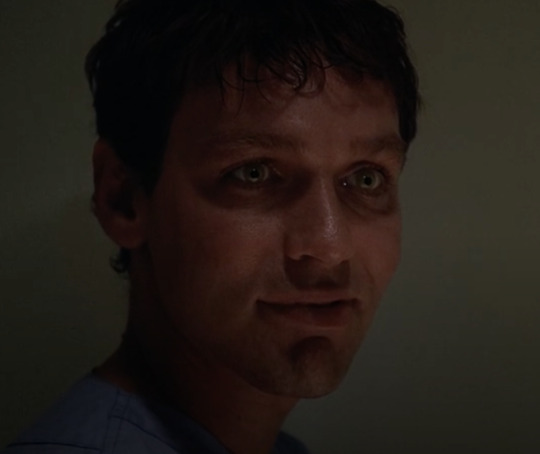
The unconscious is the part of the mind that is not directly accessible to conscious awareness, but still influences thoughts, feelings, and behaviors. Fanon describes the unconscious as containing "archetypes" and "prejudices, myths, collective attitudes" (2) that shape one's worldview, even if they are not consciously recognized. As Fanon states, "the collective unconscious is purely and simply the sum of prejudices, myths, collective attitudes of a given group". Fanon centers his argument around the identity of blackness, arguing that the "Negro is the symbol of Evil" in the "collective unconscious of homo occidentalis", representing "the bad instincts, the darkness inherent in every ego, of the uncivilized savage". (3) This unconscious association of blackness with immorality and savagery is a key part of the cultural imposition that shapes the Antillean's worldview.
When FBI Agent Tom Colton confronts Fox Mulder at the crime scene, his disdain for Mulder's unconventional beliefs is palpable. With a hint of sarcasm, Colton delivers a cutting remark, questioning Mulder's inclination towards extraterrestrial explanations: "So, Mulder, what do you think, does this look like the work of little green men?" Colton ridicules Mulder's theories and conveys his contempt for Mulder's willingness to entertain ideas outside the norm. In response, Mulder maintains his composure, brushing off Colton's skepticism with a lighthearted retort about the color of the aliens. Essentially, Colton represents the entrenched skepticism of mainstream society, grounded in rationality and empirical evidence, while Mulder embodies a willingness to explore the realms of the unknown, guided by intuition and belief in the extraordinary. (X-Files, 2003, 00:07:20) Fanon's concept of the unconscious offers insight into this dynamic. Fanon posits that individuals are shaped by unconscious forces, including societal norms and cultural biases, which influence their perceptions and attitudes towards others. In this context, Colton's dismissal of Mulder's beliefs reflects an unconscious adherence to societal norms, reinforcing the prevailing skepticism towards unconventional ideas. Meanwhile, Mulder's willingness to entertain the possibility of extraterrestrial involvement highlights the influence of his own unconscious beliefs and desires. Despite facing ridicule and skepticism, Mulder remains steadfast in his convictions, driven by a deep-seated belief in the existence of the unknown and the unexplored. In essence, Colton and Mulder's interaction serves as a microcosm of the broader societal tensions surrounding belief systems and the unconscious biases that shape individual perspectives. While Colton represents the status quo, Mulder embodies the relentless pursuit of truth, challenging the boundaries of conventional wisdom and delving into the depths of the unconscious in search of answers.

Misrecognition is a fundamental concept in psychoanalysis that refers to the distortion of perception or failure to recognize one's true identity and relationships. Lacan emphasizes that misrecognition is central to the formation of the ego and its defensive structures, stating that "the I formation is symbolized in dreams by a fortified camp, or even a stadium-distributing, between the arena within its walls and its outer border of gravel-pits and marshes, two opposed fields of battle where the subject bogs down in his quest for the proud, remote inner castle whose form (sometimes juxtaposed in the same scenario) strikingly symbolizes the id." (4) This concept underscores the idea that the ego is not centered on accurate perception but rather on a complex interplay of defenses and misperceptions.
When Mulder and Scully stumble upon Eugene Tooms' hideout in a building complex, they uncover a disturbing sight: his hibernation nest constructed from newspapers and held together by a sticky substance. As Mulder cautiously investigates the nest, his casual touch reveals the viscous texture of the adhesive, which Scully identifies as bile. In a seemingly nonchalant manner, Mulder remarks, “is there any way I can get it off my fingers quickly without betraying my cool exterior?” However, this seemingly innocuous comment belies a deeper truth about Mulder's character. Behind his usual facade of cool confidence and detachment, Mulder's response hints at an underlying vulnerability and discomfort. (X-Files, 2003, 00:31:30) By acknowledging the need to maintain his "cool exterior," Mulder unwittingly exposes the facade he presents to the world, revealing a glimpse of the inner turmoil and unease beneath the surface. This moment of revelation underscores Jacques Lacan's concept of misrecognition. Throughout the series, Mulder has projected an image of unshakeable confidence and unwavering determination. However, his offhand remark reveals the discrepancy between his outward presentation and internal reality. Just as a distorted mirror distorts one's reflection, Mulder's calm exterior masks the complexity of his inner thoughts and emotions, leading to a misrecognition of his true self. In this moment, Mulder's quip serves as a poignant reminder that appearances can be deceiving, and true understanding requires peering beyond the surface to uncover the hidden truths within.

The concepts of "Heimlich" and "Unheimlich" are central to Freud's exploration of the uncanny. Heimlich refers to that which is familiar, native, and belonging to the home. It evokes a sense of comfort, intimacy, and security. In contrast, Unheimlich is the opposite of heimlich, describing something that is uncanny, gloomy, and dismal. Freud explains that the uncanny arises when "repressed infantile complexes have been revived", (5) causing a sense of unsettling familiarity. The uncanny, therefore, represents a return of the repressed, blurring the line between the familiar and the unfamiliar.
The first significant encounter with Eugene Tooms occurs during his interrogation by the FBI, where he undergoes a polygraph test regarding the series of serial murders. Initially appearing human and unremarkable, Tooms' demeanor soon unsettles both the agents and the audience. Despite the gravity of the situation, Tooms remains eerily emotionless and detached, responding to inquiries with minimalistic yes or no answers and devoid of any visible expressions. (X-Files, 2003, 00:15:25) His uncanny composure during the interrogation contrasts sharply with the gravity of the accusations against him, leaving both the agents and viewers feeling uneasy. Although Tooms successfully passes the polygraph test, the ease with which he navigates the questioning only heightens the sense of disquiet among those present. It's as though he effortlessly conceals his true nature beneath a veneer of normalcy, blurring the line between the familiar and the unsettling. This encounter with Tooms exemplifies Freud's concepts of heimlich and unheimlich. Initially appearing heimlich, or familiar, Tooms quickly becomes unheimlich as his unnerving behavior disrupts expectations and instills a sense of unease. His ability to mask his true intentions and emotions underscores the eerie nature of the uncanny, leaving both the characters within the narrative and the audience grappling with the unsettling realization that appearances can be deceiving.
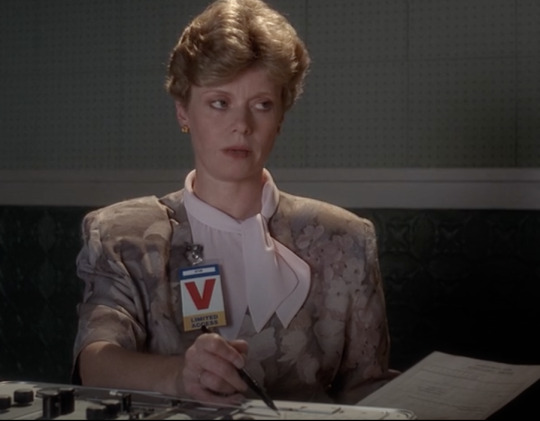
Disalienation refers to the process of overcoming the internalized beliefs and structures that perpetuate feelings of inferiority and alienation in individuals, particularly in colonized contexts. Fanon emphasizes the need for disalienation by stating, "The Negro makes himself inferior. But the truth is that he is made inferior." (6) This highlights the societal imposition of inferiority on individuals of color, leading to a distorted self-perception. Disalienation involves recognizing and challenging these imposed beliefs to reclaim one's identity and agency, as Fanon suggests when discussing the Antillean's journey to reconcile his family heritage with the expectations of European society
As Eugene Tooms undergoes interrogation by FBI agents, the power dynamics at play contribute to a profound sense of disalienation. The agents wield authority and control, leveraging interrogation techniques, including the polygraph machine, to compel Tooms into submission. Throughout the interrogation, there's a palpable imbalance of power, with the FBI agents exerting pressure on Tooms in their relentless pursuit of a confession. Their tactics aim to undermine Tooms' sense of autonomy and agency, creating an environment where he feels increasingly alienated and vulnerable. The use of the polygraph machine underscores this disalienation, as Tooms is subjected to a series of probing questions aimed at eliciting incriminating responses. The machine, designed to detect deception, serves as a tangible symbol of authority and surveillance, trying to heighten Tooms' feelings of unease and powerlessness. The agents' relentless questioning and scrutiny further compound Tooms' sense of disalienation, as he grapples with the oppressive weight of their interrogation tactics. (X-Files, 2003, 00:15:25) In this context, disalienation refers to the estrangement and loss of agency experienced by Tooms as he confronts the overwhelming power of the FBI agents. Their efforts to extract a confession through coercion and manipulation serve to reinforce his status as a marginalized and disempowered individual. As the interrogation unfolds, Tooms finds himself increasingly trying to navigate the FBI trapping and isolating him within a web of institutional authority and control.

Citations
(1) Sigmund Freud, "The Uncanny," in The Standard Edition of the Complete Psychological Works of Sigmund Freud, trans. and ed. James Strachey et al., vol. 17 (London: Hogarth Press, 1955), 369.
(2) Fanon, Frantz. "The Negro and Psychopathology." Black Skin, White Masks, trans. Richard Philcox. New York: Grove Press, 2008. p. 145.
(3) Fanon, Frantz. "The Negro and Psychopathology." in Black Skin, White Masks, 147.
(4) Lacan, Jacques. "The Mirror Stage as Formative of the Function of the I." Écrits: A Selection, trans. Bruce Fink. New York: W.W. Norton & Company, 2002. p. 78.
(5) Freud, Sigmund. "The Uncanny." in The Standard Edition of the Complete Psychological Works of Sigmund Freud, 403.
(6) Fanon, Frantz. "The Negro and Psychopathology." in Black Skin, White Masks, 115.
0 notes
Text
Midterm
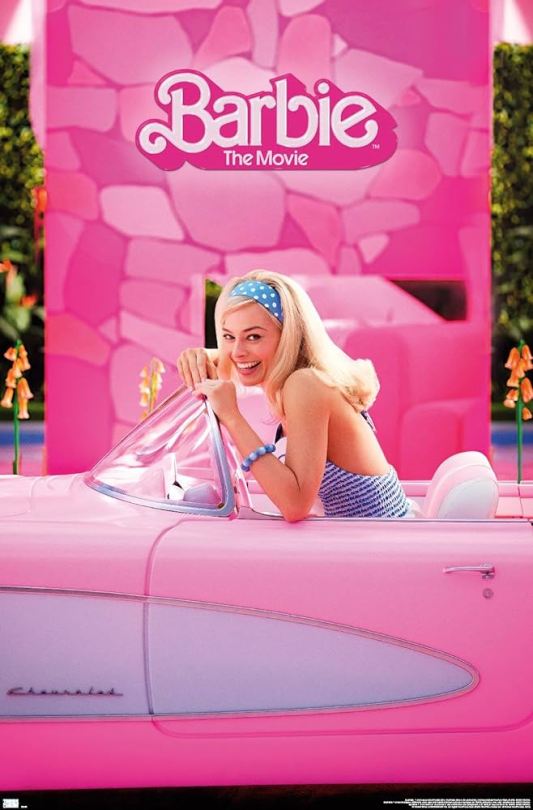
Introduction:
In 2023, the iconic Barbie doll stepped into the world of live-action cinema, portrayed by Margot Robbie and directed by Greta Gerwig. This highly anticipated film brought Barbie to life in a way never seen before, blending the doll's iconic imagery with real world struggles women around the world experience. Set against the backdrop of modern-day society, we follow Barbie as she begins to realize the perfect Barbieland she is used to, where women are powerful and well represented amongst every field, is not an accurate portrayal of what women experience in reality. The 2023 live-action Barbie movie embarked on a journey of self-discovery, woman empowerment, and embracing individuality. The film delivered a fresh take of one of the most popular characters for a new generation, a character that has represented many aspects of women throughout its existence.
In The Culture Industry as Mass Deception, Max Horkheimer and Theodor Adorno explore how mass media and popular culture manipulate and control individuals by perpetuating capitalist ideology and fostering conformity. In the collection of essays in Mythologies, Roland Barthes analyzes contemporary cultural phenomena and everyday objects to uncover the underlying myths and ideologies that shape society's understanding and perception of reality. In Introduction: Repetition and Difference, Giles Deleuze introduces the concepts of repetition and difference as fundamental to understanding the nature of reality, challenging traditional notions of identity and representation. Collectively, these theories work to expose how society struggles to balance the nature of conformity and the need for individuality.
All these readings cover different but relational aspects which this post will explore in the upcoming sections. The first section will assess the commonalities in which the theorists in these readings share. Next, how the readings differ within their theories will be discussed. Finally, this post will analyze a single scene from the film and explore how each of the theorists engages in dialogue with one another.
Section 1: Commonalities
The works of Max Horkheimer and Theodor Adorno, The Culture Industry as Mass Deception, Roland Barthes, Mythologies, and Giles Deleuze, Introduction: Repetition and Difference, share commonalities despite their differences in focus and approach. Overall, they all critique how the power of dominant cultural forms and ideologies can lead to conformity of individuals.
Horkheimer and Adorno analyze the culture industry's role in shaping mass consciousness and perpetuating capitalist hegemony. They argue that the culture industry promotes conformity and passivity through mass media, entertainment, and advertising, producing standardized content that stifles critical thinking, “infecting everything with sameness.” (1) Oftentimes through the entertainment industry, products released are often the result of prioritizing profit over artistic merit, reusing predictable plot points, sampling well known tracks, or remaking popular franchises. This results in a pool of repetitive content that while can appease a massive audience, fails to break free of the industrial conformity and provide audiences with true creativity and diversity. Through the culture industry’s mass dissemination of cultural products, the “whole world is passed through the filter of the culture industry.” (2) Using advertising and marketing, the industry has become well adept at manipulating consumer behaviors into accepting and wanting these standardized forms of entertainment. It shapes public consciousness and molds individuals into passive consumers who uncritically accept the status quo. By providing the public with standardized forms of entertainment and cultural content, the culture industry distracts individuals from questioning the underlying structures of power and inequality inherent in capitalist society.
Similarly, Barthes scrutinizes the myths embedded within everyday cultural objects and practices that work to shape societies views around dominant ideologies, which inherently results in conformity. To Barthes, myths are constructed through the process of signification, where signs (words, images, or objects) become associated with a certain meaning and become invested with cultural significance. Barthes critiques the ways in which dominant cultural forms perpetuate stereotypes, hierarchies, and power dynamics within society. When faced with things like spectacle events like wrestling, people are “completely uninterested in knowing whether the contest is rigged or not, and rightly so; it abandons itself to the primary virtue of the spectacle, which is to abolish all motives and all consequences: what matters is not what it thinks but what it sees.” (3) The public is uninterested and unaware whether the contest is rigged, reflecting the myth's ability to naturalize and normalize social phenomena. The spectacle presents itself as a neutral and objective event, despite potentially being manipulated or rigged behind the scenes. Wrestling, for example, is scripted to follow certain tropes and conventions, resulting in a sense of suspense and excitement for the audience. Through choreographed performances, wrestlers convey a narrative of struggle, triumph, and defeat. The audience accepts this presentation at face value and buys into the commodities, reinforcing the myth and perpetuating its influence, demonstrating how these myths function to uphold and naturalize prevailing power structures and social norms, thereby shaping society's views, attitudes, and behaviors.
Gilles Deleuze's concept of difference and repetition challenges dominant cultural forms and ideologies by arguing that reality is characterized by a multiplicity of unique and distinct elements, rather than uniformity or sameness, which can defeat conformity. Deleuze argues that difference is inherently everywhere, and that in itself creates the possibility for newness. In the context of challenging dominant cultural forms and ideologies, by emphasizing his idea of the true nature of reality, he highlights the individuality of every human experience and encourages individuals to embrace alternative ways of thinking and being. Dominant cultural forms and ideologies also encourage generality and conformity amongst society. Generalizing constitutes one of the most fundamental cognitive processes, necessitating repetition to achieve. According to Deleuze repetition is a contributor to generality, but in every repetition something distinct occurs, suggesting that repetition is not simply the reproduction of the same, “concerns non-exchangeable and non-substitutable singularities.”(4) Newness is inscribed in every repetition, and it is this difference that creates new change and evolution, encouraging creativity and uniqueness amongst everything. Totalizing systems that enforce dominant cultural forms and ideologies rely on repetition to maintain social order and control dissent, which seemingly prohibit difference and creativity. Deleuze challenges these systems by emphasizing the disruptive force of difference and the transformative potential of repetition.
Section 2: Differences
Horkheimer and Adorno along with Barthes present a more pessimistic view of individualism in the face of mass culture, while Deleuze offers a perspective that recognizes the agency and potential for resistance among individuals within cultural contexts.
Horkheimer and Adorno argue that mass media and standardized cultural products promote conformity and passive consumption, which in turn stifles individual autonomy and critical thinking, as people begin to buy into standardized forms of entertainment and products, suggesting that “the power of industrial society is imprinted on people once and for all.” (5) Horkheimer and Adorno suggest that the culture industry fosters a culture of mass deception, where individuals become mere recipients of pre-packaged cultural content, limiting their capacity for genuine individual expression. The commodification of culture reduces individuals to mere consumers, alienating them from their own creativity and autonomy, and results in a greater struggle for the industry to strive for creativity and newness. Similarly, Barthes emphasizes how individuals are constructed within society through cultural myths and symbols. He highlights how individuals are subject to the influence of dominant ideologies propagated through cultural products, and as a result, he believes individualism is constrained by societal norms and values perpetuated through cultural narratives. However, they do differ in how they view individualism. Barthes approaches individualism through the lens of semiotics and cultural analysis, focusing on how individuals are constructed within society through cultural myths and symbols. For Barthes, individualism is constrained by societal norms and values perpetuated through cultural narratives, highlighting the ways in which individuals are shaped by external forces beyond their control. In contrast, Adorno critiques individualism within the context of mass culture and the culture industry. He argues that individual autonomy and expression are undermined by the homogenizing effects of mass-produced cultural products, viewing individualism as illusory in consumer society. Adorno sees individuals as reduced to mere consumers, alienated from their own creativity and autonomy by the pervasive influence of the culture industry.
Deleuze takes a more positive approach to individualism. Deleuze's conception of individualism is rooted in the transformative power of difference, which enables individuals to assert their unique identities and challenge dominant cultural forms. He suggests that repetition is not just a mechanism of control but rather a site of creativity and innovation. Although repetition has a general similarity, “to repeat is to behave in a certain manner, but in relation to something unique or singular which has no equal or equivalent.” (6) Deleuze embraces the idea of difference and repetition to challenge dominant ideologies and offers a more positive view on individualism powering through general conformity. Deleuze offers evidence of how individuals can actively engage in processes of becoming, continually reinventing themselves and their environments to affirm their autonomy and agency. This positive view of individualism underscores Deleuze's belief in the creative potential of difference and repetition as a means of liberation and self-expression.
Section 3: Analyze
youtube
When Ken is first introduced to the real world, he has never before experienced a reality in which men not only have individual autonomy, but a leading dominance amongst everyone else, especially women. As he departs from Barbie’s influence and walks away to explore the world on his own terms, he discovers Director Greta Gerwig’s satirical yet strangely accurate representation of an American man in modern society. In this scene, Ken's character trait of susceptibility becomes increasingly evident. While his normal desire was to please Barbie, his natural susceptibility leads him to conform to societal expectations of what it means to be a "real man" as he is exposed to the standardized ideals of masculinity portrayed in the media. This susceptibility is a hallmark of the culture industry's influence, as Ken begins to internalize and replicate the images and narratives promoted by mass media and cultural products. The montage of masculine activities, such as golfing, wrestling, cowboys, and war, reflects the standardized representations of masculinity perpetuated by the culture industry. These images are pervasive in popular culture, shaping societal perceptions of gender roles and reinforcing patriarchal norms. Horkheimer and Adorno's concept of the culture industry as mass deception is echoed here, as Ken consumes and reproduces these standardized ideals without critical reflection. Ken's emulation of the demeaning attitudes of businessmen and his instant infatuation with the idea of horses further illustrate the culture industry's influence on shaping individual behavior and preferences. The culture industry manufactures desires and dictates societal norms, leading individuals like Ken to conform to these ideals without questioning their validity. Horkheimer and Adorno would argue that the culture industry's standardized and formulaic content serves to perpetuate conformity and passivity among individuals, stifling critical thinking and reinforcing dominant power structures. Ken's transformation into a caricature of masculinity, driven by his desire to fit societal expectations, exemplifies the ways in which the culture industry shapes and molds individual identity and behavior.
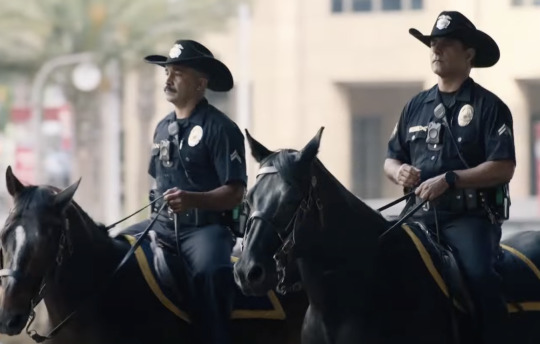
In this scene from Greta Gerwig's film, the character Ken is immediately immersed in a visual landscape that reinforces traditional notions of masculinity and power. Through the use of coloring, costumes, and setting, Gerwig creates a mise-en-scene that is highly evocative of patriarchal norms and values, drawing on the visual language of cultural myths to reinforce gender hierarchies. As Ken departs from the bright, pink colors associated with Barbie, the movie cuts to a city block dominated by large corporations and their towering buildings. The monochromatic color palette of this urban setting immediately conveys a sense of business and masculinity, aligning with traditional representations of power and authority in patriarchal society. As Ken navigates this urban landscape, he encounters various stereotypical representations of masculinity. Men in business attire populate the scene, engaged in activities such as working out at the gym, driving cars associated with male stereotypes, and riding horses. These visual cues serve to reinforce the idea of male superiority and dominance, perpetuating patriarchal norms and values. Ken is then introduced to powerful male figures throughout American history, and realizes that men in reality have always had the upper hand, and he falls in love with the patriarchal system, proceeding to buy into the spectacles of masculinity and reshaping his identity to better fit the mythical idea of a man.
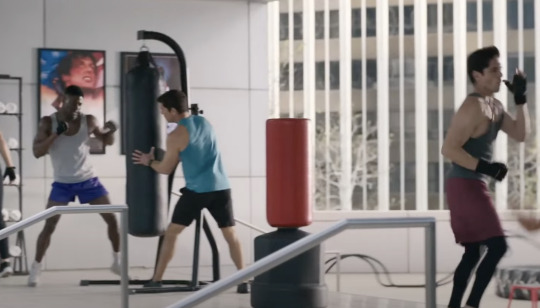
Barthes' analysis of myths offers a framework for understanding how these visual symbols and narratives function to uphold patriarchal ideologies. By examining the ways in which myths construct and perpetuate gender roles and stereotypes, Greta Gerwig sheds light on the ways in which patriarchal norms are embedded within our cultural narratives and symbols. In this scene, Gerwig's use of visual cues and symbolism effectively aligns with Barthes' analysis, demonstrating how patriarchal power structures are reinforced and perpetuated through cultural representations. Through the manipulation of signs and spectacles, Gerwig constructs a visual narrative that reflects and reinforces traditional notions of masculinity and power, echoing the themes explored by Barthes in his examination of cultural myths. In Barbie, Ken's discovery of a patriarchal world serves as a satirical commentary on the behaviors and history of men in America. Through Ken's naive perspective, Gerwig exaggerates stereotypes and portrays commonplace occurrences of male behavior, adding humorous and satirical elements to the scene. Gerwig employs Ken's naivety to enhance the portrayal of stereotypes, using his perspective as a lens to magnify the absurdities of male behavior. For instance, she ridicules the way men interact with each other by including a comical "men men men" chant, poking fun at the performative masculinity often found in male-dominated spaces. Additionally, Gerwig portrays a businessman dismissing a woman who approaches him, highlighting the gendered power dynamics prevalent in the workplace. Ken mimics this behavior, replicating the actions of the men around him and further reinforcing the patriarchal norms of the society he encounters. Gerwig's portrayal of repetition in the film follows Deleuze's concept of repetition, as she infuses the typical idea of the patriarchy with a satirical tone. She chooses to generalize and repeat what is typically associated with masculinity, but also exposes the absurdity of patriarchal norms. By employing repetition in a satirical manner, Gerwig effectively critiques the power dynamics at play in patriarchal systems, and adds newness to the portrayal of a typical patriarchy. Her use of humor serves to both entertain and provoke thought, encouraging viewers to question and challenge established norms. In Ken's replication of the patriarchal behaviors he observes, we see a form of repetition as he starts to replicate what he generally sees from the men around him, aligning with Deleuze's idea of repetition as both reinforcing existing structures. As Ken mimics the behaviors he witnesses, he inadvertently perpetuates the cycle of patriarchal ideology, perpetuating stereotypes and reinforcing gender hierarchies.

However, within this repetition lies the potential for subversion and resistance, as individuals like Ken could also challenge and disrupt established norms through their actions, reflecting Deleuze's notion of repetition as a site of both constraint and possibility. Gerwig's use of satire and repetition in portraying Ken's discovery of a patriarchal world not only provides a humorous commentary on male behavior but also offers a nuanced reflection on the complexities of power dynamics and societal norms. Through Ken's journey, the film invites viewers to consider the ways in which repetition shapes individual behavior and perpetuates patriarchal ideologies, while also suggesting the possibility of resistance and change.
Bibliography
Horkheimer, Max, and Theodor Adorno. "The Culture Industry as Mass Deception." In Dialectic of Enlightenment. Stanford University Press, 2002, 94.
Horkheimer, Max, and Theodor Adorno. "The Culture Industry as Mass Deception." In Dialectic of Enlightenment. Stanford University Press, 2002, 100.
Barthes, Roland. Mythologies. New York: Hill and Wang, 2013, 13.
Deleuze, Gilles. "Introduction: Repetition and Difference." In Difference and Repetition, translated by Paul Patton. Columbia University Press, 1994, 1.
Horkheimer, Max, and Theodor Adorno. "The Culture Industry as Mass Deception." In Dialectic of Enlightenment. Stanford University Press, 2002, 100.
Deleuze, Gilles. "Introduction: Repetition and Difference." In Difference and Repetition, translated by Paul Patton. Columbia University Press, 1994, 1.
0 notes
Text
In examining visual texts through the lens of psychoanalysis and subjectivity, the concepts of the uncanny, personal neurosis, and underrepresentation among oppressed and marginalized groups emerge as crucial focal points. According to Freud, the uncanny is “that class of the terrifying which leads back to something long known to us, once very familiar” (1). Freud attributes this sensation to the revival of repressed fears and the blurring of boundaries between the familiar and unfamiliar. Lacan expands upon this, emphasizing the role of personal neurosis in shaping subjective identity. The Mirror Stage highlights “the transformation that takes place in the subject when he assumes an image – an image that is seemingly predestined to have an effect at this phase” (2), and how individuals construct their sense of self through a process of identification with images and ideals. In contrast, Fanon's analysis delves into the psychological consequences of racial oppression and underrepresentation. Fanon argues that the lack of representation in visual media reinforces feelings of alienation and inferiority among marginalized groups, and that people tend to think "the world is white because no black voice exists” (118). The absence or minimal representation of marginalized groups in media perpetuates feelings of exclusion and otherness, contributing to their alienation and reinforcing systemic oppression.
Sigmund Freud, "The Uncanny," in The Standard Edition of the Complete Psychological Works of Sigmund Freud, ed. and trans. James Strachey, vol. 17 (London: Hogarth Press, 1955), 369.
Jacques Lacan, "The Mirror Stage as Formative of the Function of the I," in Écrits: The First Complete Edition in English, trans. Alan Sheridan (New York: W. W. Norton & Company, 2006), 76.
Frantz Fanon, "The Negro and Psychopathology," in Black Skin, White Masks, trans. Charles Lam Markmann (Grove Press, 1952), 118.
Reading Notes 6: Freud to Lacan to Fanon
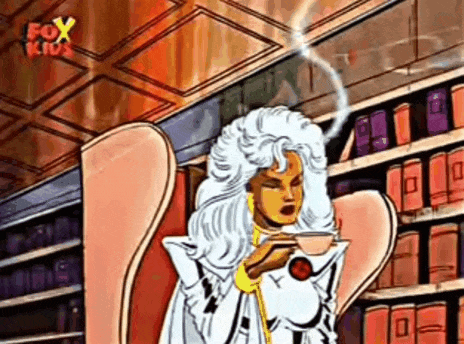
We look to Sigmund Freud’s “The Uncanny,” Jacques Lacan’s “The Mirror Stage as Formative of the Function of the I,” and Frantz Fanon’s “The Negro and Psychopathology” for our inquiry into the functions of psychoanalysis and subjectivity when examining visual texts.
Why do people call an experience or event uncanny, and what makes an occurrence that appears to be uncanny but is not uncanny?
What is the relation of personal neurosis to social passions?
In what ways are oppressed and marginalized viewers alienated when they are not or rarely represented?
@theuncannyprofessoro
16 notes
·
View notes
Text
In Baudrillard's analysis, the breakdown unfolds through four phases, each representing a departure from reality. Initially, the image faithfully reflects the real world and "is the reflection of a basic reality." As the image progresses through the phases, it distorts, "masks, and perverts a basic reality." The image becomes a tool for misleading or deceiving, as it starts to bear "no relation to any reality whatever: it is its own pure simulacrum," (1) leading to a playful or mischievous engagement with reality. This culmination in the pure simulacrum marks a state where the image exists without any connection to reality, becoming a hyperreal entity in its own right. These phases illustrate how images evolve from mere reflections to autonomous entities, blurring the boundaries between reality and simulation.
Jameson's exploration of parody and pastiche delves into the relationship between cultural forms and their representations, claiming that "pastiche is blank parody, parody that has lost its sense of humor: pastiche is to parody what that curious thing." (2) Parody initially maintains distance from its object, using humor or satire to comment on cultural phenomena. However, as parody saturates the cultural landscape, it loses its critical edge and transforms into pastiche. Pastiche involves the uncritical imitation of styles and forms, devoid of the satirical intent of parody. This shift signifies a flattening of cultural distinctions and a loss of authenticity, as pastiche proliferates in a postmodern world inundated with images and references.
Works Cited
Baudrillard, Jean, “Simulacra and Simulations” (New York, NY, Pearson Education Limited: 1992).
Jameson, Fredric, ““Postmodernism and Consumer Society”(New York, NY, Pearson Education Limited: 1992).
Reading Notes 5: Baudrillard to Jameson
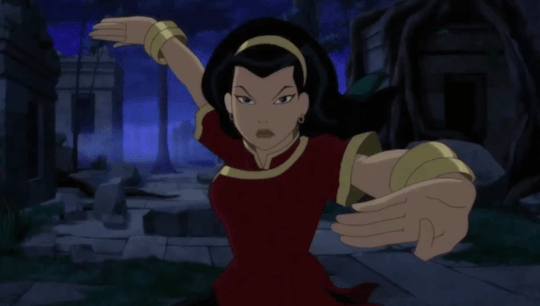
To further our studies in visual analysis, Jean Baudrillard’s “Simulacra and Simulations” and Fredric Jameson’s “Postmodernism and Consumer Society” offer guidance to understanding the roles of poststructuralism and postmodernism.
What are the four successive phases that break down an image?
What is the relationship of parody to the object it mocks, and at what point does parody become impossible and pastiche appear?
@theuncannyprofessoro
16 notes
·
View notes
Text
Music Video Analysis
Part 1: "thank u, next"
youtube
Ariana Grande's "thank u, next" music video is a vibrant homage to iconic romantic comedy movies, including "Mean Girls," "Legally Blonde," "13 Going on 30," and "Bring It On." In the video, Grande recreates memorable scenes from these films while infusing them with her own unique style and narrative, inviting famous friends and other celebrities that have been connected to her to reference her life within these recreations. Throughout the video, Grande reflects on themes of personal growth, self-love, and empowerment, and cleverly addresses her own love life and the public's fascination with it. Having publicly addressed her love for old rom-coms, she also celebrates the strength and resilience of female protagonists from the rom-coms she references. The video showcases Grande's creativity and artistic vision, as she embraces her independence and confidently moves forward after experiencing heartbreak. Overall, "thank u, next" is a visually captivating and empowering tribute to both iconic movies and Grande's own journey of self-discovery.
Deleuze explores the complex interplay between repetition, generality, and law, challenging traditional philosophical notions. Deleuze emphasizes “repetition and generality are distinct; repetition involves non-exchangeable singularities, while generality allows for exchange or substitution of terms.”(1) For him, repetition is not about replicating identical instances but rather about the emergence of difference within a repeated pattern. He argues that genuine repetition involves the recurrence of non-identical elements or singularities, which he terms "difference in itself." This notion of difference disrupts traditional conceptions of identity and sameness, highlighting the dynamic and unpredictable nature of repetition.
Each segment of the “thank u, next” music video references iconic romantic comedy movies, and represents a repetition of familiar narratives and tropes. However, rather than simply replicating these stories, Grande infuses them with her own unique perspective and experiences. We see this from the very start, when she recreates the iconic introduction of the character Regina George from “Mean Girls” (0:00:01). While the general idea and tone of the scene remains the same, she replaces Regina with herself, and inserts many references from her own life that were considered scandalous by the media, poking fun at the public’s interest. In another shot, still as Regina, Grande is scrapbooking in the famous Burn Book from “Mean Girls” (0:00:43), but instead of writing nasty secrets like the original movie does, she pays homage to her previous relationships with nothing but love and respect, aligning with the lyrics of each ex while she flips the page from one ex to the next. These reinterpretations of familiar narratives highlight Deleuze's notion of difference within repetition. Despite drawing inspiration from existing cultural tropes, Grande introduces new elements and perspectives, allowing for the emergence of difference and novelty within the repeated patterns.

Baudrillard examines the dominance of consumption and the signifier in capitalist societies, exploring how “postmodern communication technologies, principally television, are said to flood the world with self-generating, self-mirroring images; and experience” (2). He contrasts simulation with representation, arguing that simulation has replaced representation, challenging conventional notions of reality and power dynamics. Images no longer reflect reality but create their own hyperreal realm, blurring the boundaries between real and simulated experiences. His work offers a critical perspective on the impact of hyperreality, highlighting the complexities of navigating between real and simulated realms.
In "thank u, next", Grande’s idealization of high school culture and romantic comedy (rom-com) tropes contributes to the construction of a hyperreal world, resonating with Jean Baudrillard's concept of simulation. The video references iconic high school movies like "Mean Girls" and "Bring It On," as well as rom-com classics such as "Legally Blonde" and "13 Going on 30," embodying specific tropes and narratives associated with adolescence and romantic relationships. She blurs the line of reality and simulation consistently. In one instance, Grande pays homage to the movie “Legally Blonde”, where she replaces the main character, Elle, with herself. When she talks to Jennifer Coolidge in a montage referencing the iconic hair salon, who originally plays Paulette in the film, she talks about her real life relationship as Ariana Grande, while Coolidge fully embodies her original character and responds as Paulette (0:03:20). With this exaggerated and hilarious reference to the movie, Grande’s using these classic rom-com scenes to explore her own reality ends up contributing to the construction of a hyperreal realm, where the boundaries between reality and fiction are blurred, and images and narratives take on a heightened, almost surreal quality. Baudrillard argues that in hyperreality, signs and symbols no longer represent anything real but instead simulate reality itself. Grande's idealization of high school culture and rom-com tropes in "thank u, next" contributes to the construction of a hyperreal world, where the boundaries between reality and fiction are blurred, and images and narratives take on a life of their own in the realm of popular culture.
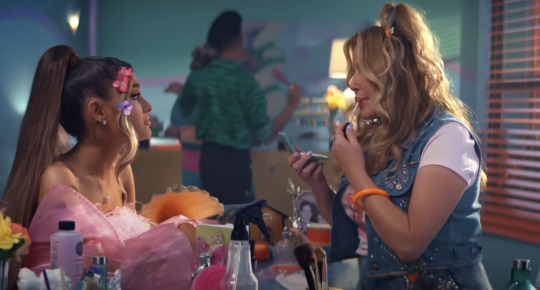
Fredric Jameson explores the impact of postmodernism on social, economic, and cultural changes, challenging the idea of a 'post-industrial' phase and highlighting capitalism's expanded hegemony. He argues that capitalism's power has intensified throughout the years, and examines how changes in capitalism's mode of production relate to new forms of cultural production, identifying postmodernism in literature, music, film, and environments as characterized by surface, pastiche, and paranoia. He discusses pastiche as a key element in postmodernism, representing a neutral mimicry without parody's satirical impulse, reflecting a shift towards stylistic diversity.
Fredric Jameson's analysis of postmodernism within the framework of consumer society underscores the dominance of capitalism in shaping cultural production and consumption. In his essay, he critiques the notion of a distinct 'post-industrial' phase, arguing instead for the expanded hegemony of capitalism. He highlights how changes in the mode of capitalist production influence cultural forms and expressions. The video itself is a product of the entertainment industry, driven by commercial interests and profit motives. It serves as a form of cultural commodity produced and consumed within a capitalist system. The references to iconic romantic comedy movies in the music video can be seen as part of a broader cultural phenomenon where nostalgia is commodified and marketed to consumers. The inclusion of many famous celebrities as the other stars in the video also highlight this obvious tactic of gaining consumer's attention. Fredric Jameson's exploration of postmodernism also offers insights into how Ariana Grande's "thank u, next" music video engages with this cultural phenomenon. Postmodernism, characterized by Jameson as a cultural shift towards surface, pastiche, and a blurring of boundaries between reality and fiction, resonates with various aspects of the music video. Grande's incorporation of references to iconic romantic comedy movies and high school culture embodies the postmodern tendency towards pastiche, where cultural elements are borrowed and recontextualized without necessarily critiquing or subverting them. While she does use them to focus on the story of her own life, the original elements of the rom-com movies aren’t particularly built on. The stylized and exaggerated portrayal of these cultural tropes reflects a focus on surface aesthetics and a blurring of the distinction between original and copied content.

Part 2: "Freedom! '90"
youtube
"Freedom! '90" is not just a music video but a statement of artistic intent by George Michael, featuring iconic supermodels (ie. Naomi Campbell, Cindy Crawford) lip-syncing the song's lyrics without himself into the video. This decision to have the models represent him was a way to signal his desire to break free from the manufactured pop star image that had defined his earlier career. The video is visually captivating, with the models of all different looks exuding confidence and attitude as they strut and pose in an abandoned mansion. Their presence symbolizes not only glamor and beauty but also a sense of power and independence. By placing the focus on these iconic figures rather than himself, George Michael effectively distances himself from his previous image and asserts his autonomy as an artist. Thematically, the video explores concepts of liberation and authenticity. It represents a departure from the glossy, commercialized imagery typically associated with pop music videos of the time. Instead, "Freedom! '90" embraces a more raw and authentic aesthetic, reflecting Michael's personal journey towards self-discovery and creative freedom.
Through the lens of Deleuze, who emphasizes the idea that repetition involves non-exchangeable singularities and challenges established norms or structures, we can analyze Michael’s music video as a unique singularity amongst music videos themselves. In contrast to typical music videos that portray the artists in a spotlighted fashion and generally shape the narratives around the presence of the singers, “Freedom! 90” chooses to feature supermodels lip-syncing to his song. This departure from the expected repetition of the artist's presence challenges the conventional structure of music videos and disrupts the established norms of representation. Additionally, his decision to step back and allow the models to take center stage can be seen as a form of resistance against the manufactured image and commercial pressures often associated with the music industry. In this video, he intentionally distances himself from his previous image, which is symbolically conveyed through visual elements, like leaking water. Water is often associated with purification and renewal, and its presence in the video suggests a cleansing process—a metaphorical washing away of the old to make room for the new. As the water pours from various sources like the walls and the ceiling (0:03:22), it represents a release from the pressures and expectations of celebrity, allowing George Michael to distance himself from his previous image and embrace a fresh start. By breaking away from the expected repetition of celebrity presence, the video embraces a new form of repetition—one that is non-exchangeable and challenges the norms of representation and identity.
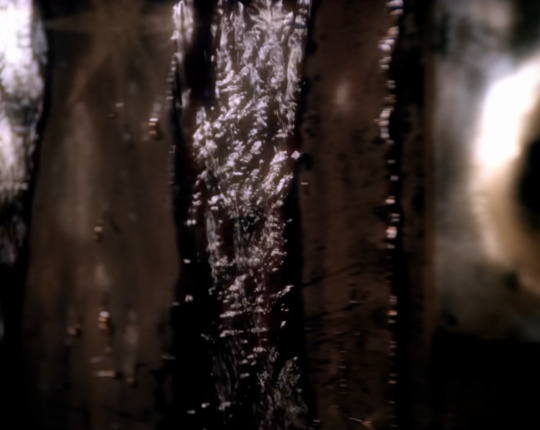
In Baudrillard's framework, Michael’s breaks free of the traditional simulation of artists we typically see from the music industry. Many artists in the music industry are carefully curated and marketed by record labels to fit specific personas or images that appeal to target demographics. These constructed identities don’t reflect the artist's true self or experiences, leading to a simulated version of their identity being presented to the public. The music industry relies heavily on media coverage and public relations strategies to shape public perception of artists and their work. In his early years as a pop star with Wham! and as a solo artist, George Michael was presented to the public as a polished, marketable figure with carefully curated image and persona. This manufactured image, while successful commercially, often overshadowed his true identity and artistic intentions. In later years, George Michael sought to break free from the constraints of his manufactured pop star image and assert his authenticity as an artist. As his lyrics illustrate the process of “breaking free” and deviating from societal expectations, he includes the iconic blazing jacket (0:2:18). The blazing jacket worn by a model in the video serves as a powerful metaphor for shedding the past and breaking free from the constraints of fame. As the jacket ignites and burns, it represents the destruction of the old persona—the glossy, manufactured pop star image that George Michael had become known for. By showcasing the jacket engulfed in flames, the video symbolizes the artist's desire to let go of his past identity and emerge anew.
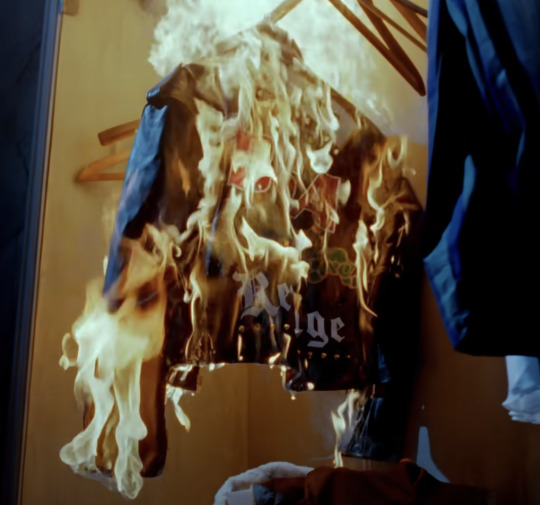
Jameson warns readers about the “death of the subject”(3), refers to a shift in postmodern culture where traditional notions of individuality and personal identity are destabilized or decentered. This concept suggests that in contemporary society, the individual subject becomes increasingly fragmented and deconstructed, unable to maintain a coherent sense of self amidst the complexities of postmodern life. He argues that various cultural and technological developments, such as the rise of mass media, globalization, and digital communication, contribute to the dissolution of the subject. These forces work to erode the boundaries between individual and collective identity, as well as between public and private spheres. As a result, the subject is no longer able to maintain a stable and unified identity but instead becomes fragmented and dispersed across multiple discourses and social contexts. In George Michael's "Freedom! '90" music video, he subverts the notion of the "death of the subject" by reclaiming agency and autonomy over his own identity and artistic expression. Towards the end of the video, the jukebox and guitar previously featured are blown up. These actions can symbolize a radical departure from the artist's past image and musical style. These acts can be seen as symbolic gestures of rebellion against the commodification of music and the constraints of traditional celebrity culture. The jukebox and guitar represent established symbols of music consumption and rock star imagery. By blowing them up, the video rejects the superficiality and commercialism associated with these symbols, challenging the idea that music and art can be reduced to mere commodities for consumption. Instead, it asserts the importance of authenticity and creative freedom in the face of commercial pressures. It can also signify a declaration of independence and a refusal to conform to expectations imposed by others. Additionally, the destruction of these symbols may represent a desire to start anew and redefine oneself creatively. Blowing up the jukebox and guitar in the music video can be interpreted as a symbolic act of liberation and a statement of artistic autonomy, subverting Jameson’s idea of “death of the subject” and challenging established norms and cultural expectations.
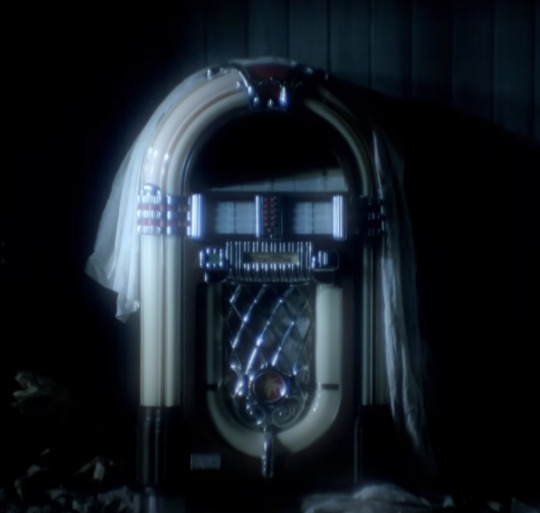
Questions:
- How does Grande's use of references to iconic movies contribute to the construction of a hyperreal realm, as discussed by Baudrillard? What insights does this offer into the dynamics of cultural consumption, representation, and the construction of reality in the digital age?
- How does Ariana Grande's "thank u, next" music video embody Jameson’s idea of postmodern tendencies, particularly in the video’s engagement with commercialized nostalgia and use of fame?
- How does Deleuze's notion of repetition involving non-exchangeable singularities help us understand the significance of this departure from the expected repetition of celebrity presence? How does it contribute to the exploration of authenticity and artistic autonomy in the video?
Works Cited
Deleuze, Giles, "Introduction: Repetition and Difference" (New York, NY, Columbia University Press: 1994).
Baudrillard, Jean, “Simulacra and Simulations” (New York, NY, Pearson Education Limited: 1992).
Jameson, Fredric, ““Postmodernism and Consumer Society”(New York, NY, Pearson Education Limited: 1992).
8 notes
·
View notes
Text
In the realm of film theory, Christian Metz’s “Some Points in the Semiotics of the Cinema” and Giles Deleuze’s “Introduction: Repetition and Difference” stand as seminal texts that offer profound insights into the nature of cinema. Metz delves into the intricate semiotic structures that underpin cinematic texts, while Deleuze explores the philosophical concepts of repetition and difference within the realm of film. Together, these readings provide a rich tapestry of ideas that deepen our understanding of the expressive potential of cinema.
Metz's exploration of semiotics in cinema underscores the importance of signs and symbols in constructing meaning within films. He argues that cinematic texts operate within a complex system of signification, where visual and narrative elements work in tandem to convey nuanced ideas and emotions to the audience. He argues that "the study of the cinema as an art—the study of cinematographic expressiveness—can therefore be conducted according to methods derived from linguistics… In literature, the latter appears as the purely linguistic signification, which is linked, in the employed idiom, to the units used by the author."(1) Essentially, he highlights how film analysis can be approached similarly to linguistic analysis, emphasizing the importance of understanding the signification within cinema
On the other hand, Deleuze's philosophical examination of repetition and difference offers a thought-provoking perspective on how cinema generates new meanings and experiences through the repetition of images and motifs. He believes that we should "make something new of repetition itself: connect it with a test, with a selection or selective test; make it the supreme object of the will and of freedom", (2) and urges us to reimagine repetition as a creative act. Instead of viewing it as a mere duplication of the same, he encourages us to infuse repetition with novelty and innovation. By connecting repetition with a test or selective process, Deleuze suggests that we should approach it as an opportunity for exploration and experimentation.
In conclusion, Metz and Deleuze provide complementary insights into the multifaceted nature of cinema, enriching our understanding of this dynamic art form. Through their respective lenses of semiotics and philosophy, they invite us to engage critically with the ways in which films communicate and resonate with audiences.
Christian Metz, "Some Points in the Semiotics of the Cinema" (New York: Oxford University Press, 1980), 67.
Metz, Christian. "Some Points in the Semiotics of the Cinema." In Movies and Methods: An Anthology, edited by Bill Nichols, 2nd ed., 166-178. Berkeley: University of California Press, 1985, 6.
Reading Notes 4: Metz to Deleuze

Christian Metz’s “Some Points in the Semiotics of the Cinema” and Giles Deleuze’s “Introduction: Repetition and Difference” transitions our inquiry from semiotics and structuralism to poststructuralism and postmodernism.
How are connotations used to signify style, genre, symbol, or poetic atmosphere in film?
How is repetition different from generality, and how is repetition different from resemblance?
@theuncannyprofessoro
13 notes
·
View notes
Text
Analytical Application 2: Structuralism and Semiotics
Sign:
The term "sign," which is defined by Ferdinand de Saussure in "Course in General Linguistics," essentially discusses its meaning in semiotics, comprising a signifier and a signified. The signifier represents the physical form or representation of the sign, while the signified denotes the concept or meaning associated with it. Saussure emphasizes the arbitrary nature of signs, stating, "the bond between the signifier and the signified is arbitrary" (2), highlighting the role of cultural conventions in shaping meaning.
Saussure's definition of the sign as a combination of the signifier and the signified relates to the Poltergeist (1982) poster in several significant ways. In the poster, the signifier is the visual representation of a little girl sitting in front of a glowing television screen, with ghostly hands reaching out towards her, all set within a dark room. The dark room serves as the backdrop, intensifying the ominous atmosphere and heightening the sense of fear and suspense conveyed by the poster. This image serves as the physical form that communicates the concept of fear and supernatural horror (the signified) associated with the movie. The glowing television and the ghostly hands are signifiers that evoke the idea of paranormal activity, while the presence of the innocent-looking young girl amplifies the sense of vulnerability and danger. Together, these elements form a cohesive sign that conveys the central themes and emotions of the film to potential viewers. Just as Saussure's theory suggests, the relationship between the signifier (the visual elements of the poster) and the signified (the concepts of fear and horror) is arbitrary, relying on cultural conventions and associations to convey meaning. The ghostly hands, for example, signify danger and supernatural presence due to their association with horror tropes, while the innocent girl represents vulnerability and the potential victim of these supernatural forces. This arbitrary connection between the signifier and the signified allows the poster to effectively communicate the film's intended message and evoke specific emotional responses from viewers. In essence, the Poltergeist poster exemplifies Saussure's theory of the sign by demonstrating how visual elements combine to communicate abstract concepts and emotions to the audience, highlighting the power of semiotics in shaping our understanding and interpretation of visual media.

Shot:
Christian Metz's concept of a "shot" in film refers to a continuous sequence of images captured by the camera, forming a fundamental unit of cinematic language. He compares it to a linguistic statement, stating that "a shot is less unlike a statement than a word, but it does not necessarily resemble a statement" (2). Unlike a single word with a clear meaning, a shot in cinema is more complex and open to interpretation. Metz highlights the unique nature of the shot as a visual unit of meaning, distinct from linguistic statements in structure and function, yet essential for conveying narrative in film.
In the poster of "Catch Me If You Can" (2002), the depiction of arrows and a blurry background shot of Leonardo DiCaprio and Tom Hanks, with DiCaprio slightly ahead of Hanks, evokes a sense of pursuit and chase. The arrows, symbolizing direction and urgency, guide the viewer's attention towards the central figures, enhancing the poster's narrative depth. This visual composition reflects Christian Metz's concept of a "shot" in film, capturing a moment frozen in time and conveying both movement and emotion. The blurry background shot of DiCaprio and Hanks represents a pivotal scene in the film's storyline, where they engage in a cat-and-mouse chase. DiCaprio's slight lead over Hanks adds tension to the composition, emphasizing the dynamic nature of their pursuit. This blurriness adds a sense of dynamism and suspense, evoking the fast-paced nature of the narrative chase. Just as the blurred shot obscures details and creates a sense of uncertainty, the tagline "The true story of a real fake" reinforces this theme by questioning the authenticity of identity and reality. The blurriness adds an element of intrigue and mystery, mirroring the ambiguity surrounding Frank Abagnale Jr.'s true identity and motives. It suggests that the characters' pursuit of truth and justice is not straightforward, and the line between truth and falsehood is blurred. Thus, the blurred shot complements the tagline by visually representing the film's exploration of deception and the complexities of truth and authenticity. It highlights the contrast between action and stillness, a central theme in Metz's theory of shots in film. Overall, the poster effectively translates Metz's concept of a shot into a visually compelling promotional image, engaging viewers and enticing them to explore the narrative further. By incorporating these elements into the poster design, the filmmakers demonstrate a sophisticated understanding of cinematic language and its ability to convey narrative depth through visual composition.

Filmic Narrative:
Christian Metz's concept of "filmic narrative" refers to the unique storytelling structure employed in cinema, characterized by its visual and temporal aspects. Metz emphasizes the cinematic medium's ability to convey narratives through a combination of moving images, sound, and editing techniques, creating a distinct mode of storytelling. As Metz notes, "Today, still, the so-called filmic procedures are in fact filmic narrative" (4), highlighting the centrality of narrative elements within the language of cinema. He credits filmmakers like D.W. Griffith for defining and unifying various filmic procedures into a coherent narrative syntax. This demonstrates how the evolution of cinema has led to the establishment of filmic narrative as a fundamental aspect of filmmaking. Metz's analysis underscores the importance of understanding narrative structures in film semiotics, as they shape the viewer's interpretation and engagement with cinematic texts.
The poster of "La città prigioniera [Conquered City]" (1962) presents a condensed version of the film's storyline through its visual depiction. It features the prominent characters, like the 2 spies and the woman that stands “between them”. It seems to include pivotal scenes, or symbolic imagery that hint at the central themes and plot points of the narrative. For instance, the poster showcases images of the two spies in conflict, with one holding a sniper aimed at the window of a woman seemingly having an affair, while the large figurehead of the other spy glares back in retaliation, facing each other off and grappling with the fate of the woman. These visual elements serve to evoke the overarching storyline of the film, which may revolve around themes of love, betrayal, and secrecy. Additionally, the poster utilizes colors, lighting, and composition to convey the contrasting mood and atmosphere of the characters, showing one spy in green, dark colors while illuminating the other figure with bright yellow with shades of green, hinting further at the rivalry. By offering viewers a glimpse into the narrative world of "Conquered City," the poster functions as a visual invitation, enticing audiences to engage with the film's storyline and immerse themselves in its compelling drama and intrigue.

Diegesis:
Christian Metz defines "diegesis" as the fictional world created within a film, encompassing all elements that are part of the narrative space. This concept highlights the distinction between the narrative events and characters presented within the film and the real-world context outside of it. In essence, diegesis refers to the internal coherence and logic of the film's storyworld, separate from the viewer's external reality. Metz emphasizes the importance of diegesis in understanding the language of cinema, stating that "the concept of diegesis is as important for the film semiologist as the idea of art" (4). He underscores the role of diegesis in conveying narrative elements such as successivity, temporal breaks, causality, and spatial relationships, which are central to the semiotics of cinema. This perspective highlights the film's capacity to construct and communicate complex narratives through its denotative procedures, contributing to the richness and depth of cinematic expression.
Christian Metz's concept of "diegesis" provides a lens through which to analyze the elements depicted in the Joyeux Noël movie poster and their contribution to the film's narrative world. The snowy landscape portrayed in the poster is a central aspect of the diegesis, symbolizing purity, tranquility, and renewal. However, this serene backdrop is juxtaposed with the presence of soldiers in military uniforms, suggesting underlying conflict and tension within the diegetic space. The soldiers' attire further reinforces the diegesis by situating the narrative within the context of war. Their somber expressions and the barren, desolate landscape, with only the presence of the two sides of war in the background, vividly convey the harsh realities of conflict and the toll it takes on individuals. Despite the tranquil setting, the soldiers' presence implies a disruption to the peace, highlighting the stark contrast between innocence and destruction within the diegesis. Overall, Metz's concept of diegesis helps viewers understand the intricate narrative world depicted in the Joyeux Noël movie poster, providing insight into its themes and emotions and inviting deeper engagement with the film's story.

Connotation:
In his seminal work "Film Language: A Semiotics of the Cinema," Christian Metz defines connotation as the symbolic meanings associated with cinematic signs, wherein the signifier motivates the signified but is surpassed by it. Metz elucidates this concept, stating, “cinematographic connotation is always symbolic in nature: The significate motivates the signifier but goes beyond it. The notion of motivated overtaking (depassement motivé) may be used to define almost all filmic connotations.”(5) This notion of "motivated overtaking" characterizes many filmic connotations, wherein the connotative elements transcend the literal signifiers, contributing to the rich semiotic landscape of cinema.
Christian Metz's concept of connotation offers a lens through which to analyze the Rush Hour movie poster, delving into the symbolic meanings inherent in its visual elements. The presence of protagonists Jackie Chan and Chris Tucker, prominently featured in the foreground with dynamic poses and expressions, conveys a sense of action, comedy, and partnership. Their body language and facial expressions evoke a lighthearted and adventurous tone, suggesting the film's genre and thematic elements to potential viewers. Moreover, the juxtaposition of Chan and Tucker against the backdrop of a bustling city skyline further reinforces the connotations of urban setting, excitement, and fast-paced adventure. Metz's theory underscores the idea that these visual elements extend beyond their literal representation, symbolically evoking broader associations and expectations related to the film. The characters' positioning and expressions serve as visual cues that trigger audience interpretations and anticipations regarding the narrative and tone of Rush Hour. Additionally, the use of red and yellow hues throughout the poster, including the yellow crime scene tape wrapped around the image, conveys connotations of urgency, danger, and action, further enhancing the poster's visual impact. By examining the Rush Hour poster through the lens of Metz's concept of connotation, one gains insight into the ways in which visual elements are strategically employed to communicate genre, tone, and thematic content to the audience. The poster serves as a visual invitation that encapsulates the essence of the film, enticing viewers with its promises of action, comedy, and urban adventure, while also offering glimpses into the dynamic relationship between the lead characters portrayed by Chan and Tucker.

Ferdinand de Saussure, Course in General Linguistics, trans. Wade Baskin [New York: McGraw-Hill, 1966], 67.
Christian Metz, "Some Points in the Semiotics of the Cinema" (New York: Oxford University Press, 1980), 75.
Metz, "Some Points in the Semiotics of the Cinema," 67.
Metz, "Some Points in the Semiotics of the Cinema," 76.
Metz, "Some Points in the Semiotics of the Cinema," 72.
0 notes
Text
Ferdinand de Saussure's Course in General Linguistics and Roland Barthes's Mythologies look into the nature of semiotics and structuralism. Saussure lays the groundwork for understanding language's structural nature and the intricate relationship between form and meaning, while Barthes explores how myth operates as a semiological system, conveying cultural meanings and ideologies through signs and symbols.
Saussure explores the foundational concepts of semiotics and structuralism, emphasizing the arbitrary nature of signs and stating "the bond between the signifier and the signified is arbitrary"(1), and introduces the concept of the linguistic sign, comprising the signifier and the signified. He asserts that "language is a system of signs that express ideas"(2). This lays the groundwork for understanding language's structural nature and the intricate relationship between form and meaning.
Barthes delves into the realm of cultural analysis and semiotics. He reveals how myth operates as a semiological system, stating, "myth is a type of speech"(3), conveying cultural meanings and ideologies through signs and symbols. By imbuing everyday objects and concepts with symbolic significance, myths shape collective understanding and maintain social order.
Through Saussure's exploration of linguistic signs and Barthes's analysis of myth, we gain insights into the complex ways in which signs and symbols construct meaning and shape societal norms. These readings provide a foundation for analyzing language, communication, and culture through a semiotic lens, demonstrating the enduring relevance of semiotics and structuralism in contemporary discourse.
(1) Ferdinand de Saussure, Course in General Linguistics (Chicago: Open Court Publishing, 2011), 22.
(2) Saussure, Course in General Linguistics, 12.
(3) Roland Barthes, Mythologies (New York: Hill and Wang, 2012), 35.
Reading Notes 3: Saussure to Barthes

In “Course in General Linguistic” and “Mythologies,” Ferdinand de Saussure and Roland Barthes set the groundwork for our studies in semiotics and structuralism.
What is the arbitrary nature of the sign, how is the sign differentiated from a symbol, and why is language the most characteristic of all sign systems?
In what ways is myth a semiological system?
@theuncannyprofessoro
17 notes
·
View notes
Text
Analytical Application (Advertisement)
Culture Industry → Alexa
Horkheimer and Adorno describe the concept of the "culture industry” as the system where capitalist industries mass-produce cultural goods. According to them, this process standardizes and homogenizes cultural products to cater to mass consumption, resulting in formulaic content. They argued that this industrialization of culture deceives and manipulates the masses, as “the whole world is passed through the filter of the culture industry,”(1) insinuating that capitalist ideologies while stifling genuine artistic expression and critical thought.
The advertisement exemplifies the mass production and standardization of cultural products for wide consumption. Produced by Amazon, a major corporation that serves as one of the top conglomerates within the capitalist industries, the ad serves as a strategic marketing tool aimed at reaching a broad audience. Crafted to resonate with its target demographic, the ad employs humor and celebrity appearances to engage viewers and leave a lasting impression. Additionally, the ad was aired during the 2019 Super Bowl, a widely watched event that exposes millions of viewers to the company and its product. The advertisement underscores the commodification of celebrities within the culture industry. Featuring well-known personalities like Gordon Ramsay and Cardi B, the ad capitalizes on their fame to attract attention and generate interest. By using different celebrities across many different industries, they show how the Echo can essentially be involved in any aspect of life. These celebrities are transformed into commodities, used as instruments to endorse products and perpetuate consumer culture. The ad also highlights the influence of technology on contemporary cultural consumption. With smart speakers like the Echo becoming increasingly integrated into daily life, they shape how people interact with technology and consume media, and enforce the idea of an easy and good life with the help of their product. By promoting the Echo device, the advertisement reinforces the notion of technology as an indispensable component of modern living, solidifying its position within consumer culture, trying to cater towards mass consumption amongst all demographics.
youtube
Dominant Hegemonic Position → Snickers
Stuart Hall's concept of the dominant-hegemonic position depicts the prevailing stance held by powerful groups in society, influencing cultural norms, values, and media representations. This position shapes societal ideologies and practices, accommodating contradictions and conflicts with alternative interpretations. It reflects the unequal distribution of power and resources, wherein dominant groups maintain authority through the dissemination of their ideologies and control over cultural institutions, and “it serves to reproduce the dominant definitions precisely by bracketing their hegemonic quality.”(2) Hall's framework highlights the complex dynamics of power and resistance within society, illustrating how dominant ideologies are both reinforced and contested through cultural production and media discourse.
Stuart Hall's theory of the dominant-hegemonic position offers a framework for analyzing the interplay between power dynamics and cultural representations in media, exemplified by Mr. T's Snickers commercial. In the ad, Mr. T's dramatic entrance onto a soccer field in a military tank, hurling insults and a Snickers bar, embodies cultural ideals of masculinity, toughness, and charisma. This portrayal aligns with dominant cultural norms, presenting Mr. T in a humorous context that reinforces perceptions of his tough persona as the Snickers spokesperson. The commercial's slogan, "Get Some Nuts," further emphasizes this image. By showcasing Mr. T in this manner, the ad reinforces the hegemonic influence of dominant cultural figures in shaping societal narratives. Essentially, the commercial reflects the pervasive societal expectation for men to conform to a tough, masculine ideal. It perpetuates the notion that toughness and power are synonymous with masculinity, reinforcing existing gender norms. This portrayal not only reflects but also reinforces the dominant cultural discourse surrounding masculinity, highlighting the influence of powerful figures like Mr. T in shaping and perpetuating these ideals. In essence, the ad serves as a microcosm of broader societal dynamics, illustrating how dominant cultural figures reinforce and perpetuate prevailing ideologies through media representations.
youtube
Ruling Class --> German
According to Marx and Engels, the ruling class refers to the socioeconomic group that owns and controls the means of production within a capitalist society. This class, typically comprising wealthy capitalists and industrialists, holds significant power and influence over the economy, politics, and culture. They accumulate wealth and privilege through the exploitation of the labor of the working class, who are relegated to selling their labor for wages. For the ruling class, “their ideas are the ruling ideas of the epoch”(3) and they perpetuate its dominance through ownership of property, control of institutions, and shaping of societal ideologies to maintain and further their economic interests, thus perpetuating class inequality.
Marx and Engels' concept of the ruling class, which centers on the socioeconomic group that controls the means of production and wields significant power and influence within society, can be discerned in the Berlitz German Coastguard commercial, particularly through the dynamics of power and social hierarchy depicted. In the commercial, the German Coastguard officer symbolizes authority and control over maritime operations. However, when confronted with an emergency call in English, the officer's evident lack of understanding and proficiency in the language exposes a form of incompetence or disconnect from the realities faced by individuals relying on clear communication for their safety, showing how his authoritative position as inherently useless due to his lack of English fluency. The commercial's concluding message, "Improve Your English," underscores a deeper societal commentary. It suggests a narrative where the ruling class, primarily Western English-speaking societies, imposes their notion of English as the dominant language onto foreigners. This imposition serves to perpetuate English dominance and reinforces the hegemony of Western culture and values, echoing Marx and Engels' assertion of the ruling class exerting its influence to maintain control and further its interests. Furthermore, the commercial implicitly critiques the power dynamics inherent in linguistic imperialism, where dominant languages are imposed on others, often at the expense of indigenous languages and cultures. It underscores how language proficiency can be a tool of social control and exclusion, with English proficiency becoming increasingly essential for access to economic opportunities and participation in global society.
youtube
Ideology → She’s Always A Woman
Louis Althusser conceptualizes ideology as a system of beliefs and values that serves to reproduce and perpetuate existing social relations of domination and exploitation. In Althusser's framework, ideology is the system of the ideas and representations which dominate the mind of a man or a social group” (4), and operates through Ideological State Apparatuses (ISAs), such as schools, churches, media, and family, which disseminate dominant ideologies and shape individuals' subjectivities. These ideologies function to maintain the stability of capitalist societies by concealing the inherent contradictions and inequalities within them. He emphasizes the role of ideology in shaping individuals' consciousness and ensuring their compliance with the prevailing social order. Ideology, for Althusser, is not simply false consciousness but a material force that structures social reality and reinforces the dominance of ruling class interests.
Althusser's idea of ideology can be applied to the John Lewis "She's Always a Woman" commercial by examining how it reflects and perpetuates certain cultural norms and values. In the commercial, viewers are presented with a series of montages showing a woman throughout various stages of her life, from childhood to adulthood, showcasing her diverse roles and experiences. The narrative constructs a specific image of femininity that aligns with traditional gender norms and expectations, such as nurturing, caregiving, and emotional strength. Althusser's concept of ideology comes into play here as the commercial functions as an Ideological State Apparatus (ISA), disseminating dominant ideologies about gender roles and relationships. By portraying the woman in stereotypical roles and reinforcing traditional notions of femininity, the commercial contributes to the reproduction of gendered social relations and expectations. It presents a particular image of womanhood that serves to maintain the status quo and uphold existing power structures. The commercial may also be seen as naturalizing and legitimizing these gendered ideologies by presenting them as inherent and unchangeable aspects of social reality. This naturalization process obscures the social construction of gender and reinforces the idea that certain roles and behaviors are innate rather than socially constructed. This ideology provides a framework for understanding how the John Lewis commercial operates as a cultural text that disseminates and reinforces dominant ideologies about gender. It highlights the ways in which media representations contribute to the reproduction of social norms and power dynamics, ultimately shaping individuals' perceptions and behaviors in accordance with the prevailing social order.
youtube
Negotiated Code → Tide
Stuart Hall's negotiated code refers to audiences' active interpretation of media messages, deviating from the dominant reading. Audiences negotiate meanings based on personal experiences and social contexts, accepting or resisting dominant ideologies encoded in texts, “reserving the right to make a more negotiated application to ‘local conditions.’”(5) Unlike dominant readings, negotiated interpretations involve complex engagements, where audiences partially accept, modify, or reinterpret encoded messages to align with their perspectives. This highlights audience agency in decoding and making meaning from cultural texts, contributing to diverse interpretations within a cultural context.
In the Tide Super Bowl Commercial "It’s a Tide Ad," negotiated code comes into play as viewers actively engage with the advertisement's messages in a manner that goes beyond the surface-level presentation. The commercial employs humor and self-awareness to subvert traditional advertising conventions, with actor David Harbour humorously asserting that every scene is actually a Tide advertisement due to the cleanliness of the characters' clothing. Viewers may negotiate the meaning of the ad by recognizing and engaging with its playful deconstruction of advertising tropes, like a typical car ad or the typical soda ad formula. Instead of passively accepting the ad's intended message at face value, viewers negotiate their interpretations by appreciating the ad's cleverness, irony, and meta-narrative elements. This negotiated reading allows viewers to actively participate in the construction of meaning, drawing upon their own cultural experiences and sensibilities to interpret the advertisement in a nuanced way. By embracing the ad's humor and subversive elements, viewers demonstrate their agency in decoding and making sense of cultural texts, contributing to a richer and more varied reception of the advertisement's message. In essence, negotiated code highlights the active role of viewers in shaping their understanding of media content, showcasing their ability to engage critically with advertising messages and extract meaning beyond what is explicitly presented.
youtube
Bibliography
(1) Max Horkheimer and Theodor W. Adorno, "The Culture Industry: Enlightenment as Mass Deception," in The Cultural Studies Reader, 2nd ed., ed. Simon During (London: Routledge, 2007), 99.
(2) Stuart Hall, "Encoding, Decoding," in *The Cultural Studies Reader*, 2nd ed., ed. Simon During (London: Routledge, 2007), 516.
(3) Karl Marx and Frederick Engels, Collected Works, vol. 5 (New York: International Publishers, 1976), 59.
(4) Louis Althusser, "Ideology and Ideological State Apparatuses (Notes towards an Investigation)," in The Anthropology of the State: A Reader, ed. Aradhana Sharma and Akhil Gupta (Oxford: Blackwell Publishing, 2006), 98.
(5) Hall, "Encoding, Decoding," 516.
0 notes